Solar Breakthroughs Bring Us Closer To a Renewable Energy Future
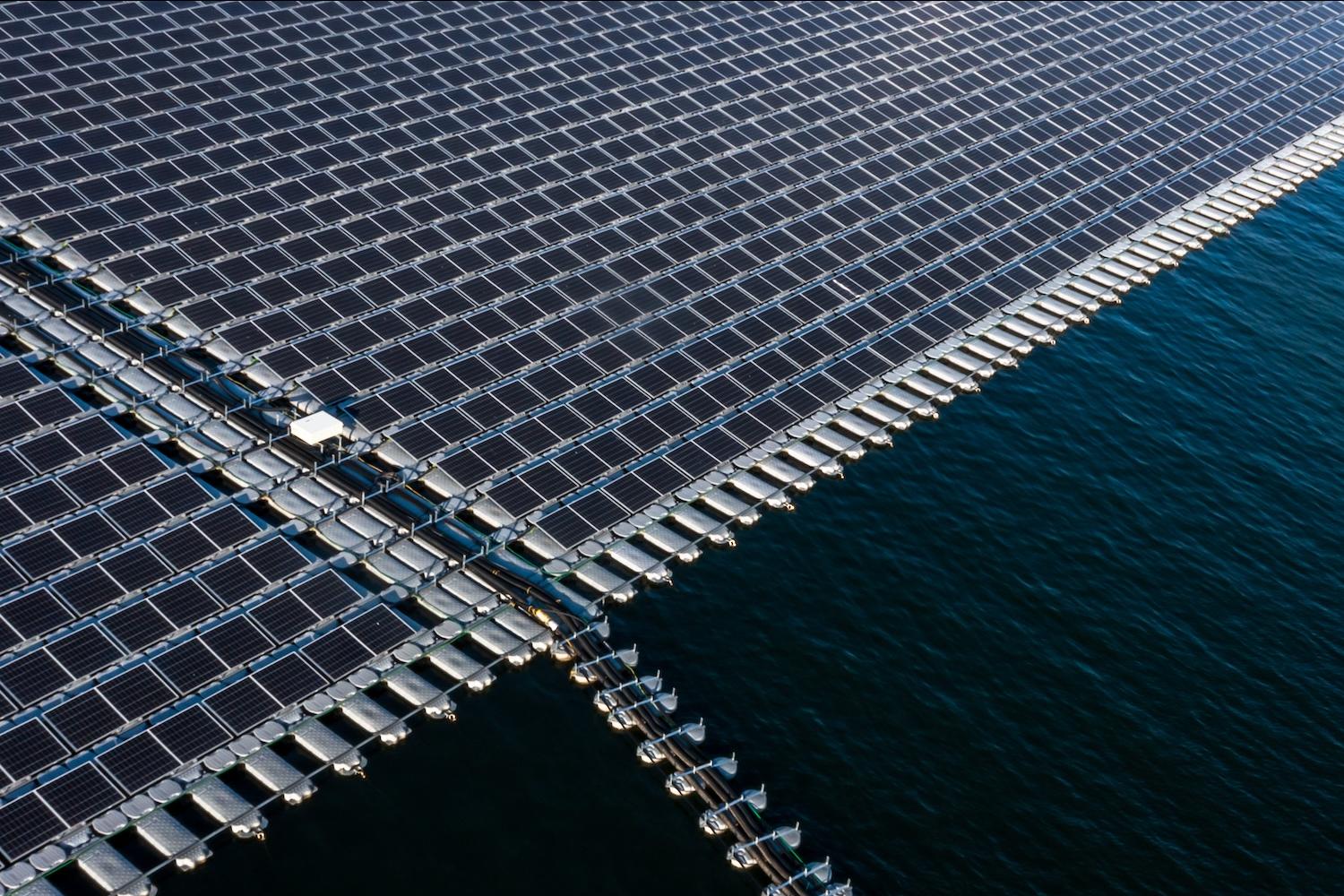
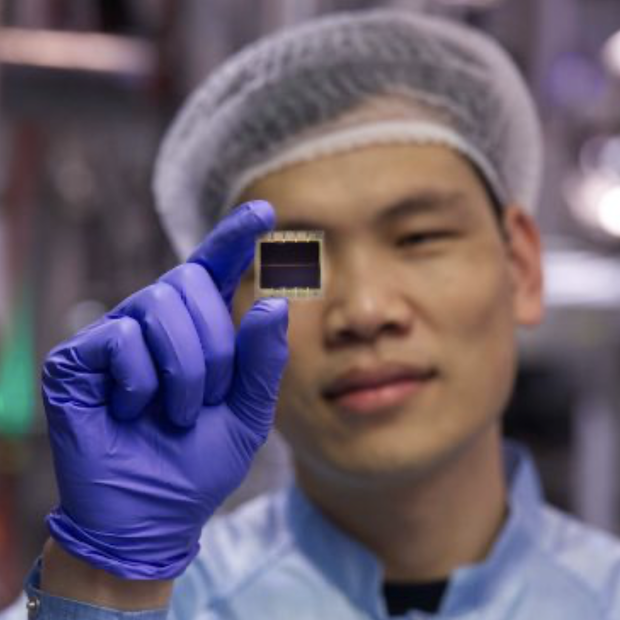
New promise for floating solar is just one of the innovations that crossed our desks this summer. (Image: Kalyakan/Adobe Stock)
Solar energy innovations are all over the news as scientists develop new ways to produce more power from the sun and the true potential of solar to reduce emissions becomes clear. Generating energy from solar and wind is now cheaper than oil and gas in most scenarios, and investment in renewables is set to double investment in fossil fuels this year.
That all adds up to more countries meeting more of their energy needs with renewable sources. The European Union met half its power needs with renewable energy from solar, wind and hydropower in the first half of 2024, and the bloc's use of solar power in particular increased by over 30 percent since 2020. With efficiency upgrades and game-changing design shifts on the horizon, the world's love affair with solar is just getting started. Read on for some of the hottest news that crossed our desks this summer.
Solar without the panels? Printable and paintable solar could soon be a reality
Scientists at Oxford University say they've developed an ultra-thin and flexible material that can be applied as a coating on objects like building walls, roofs, cars and cell phones to generate solar energy without the need for solar panels. “If more solar energy can be generated in this way, we can foresee less need in the longer term to use silicon panels or build more and more solar farms,” Junke Wang of Oxford’s physics department said in a statement released by the university last week.
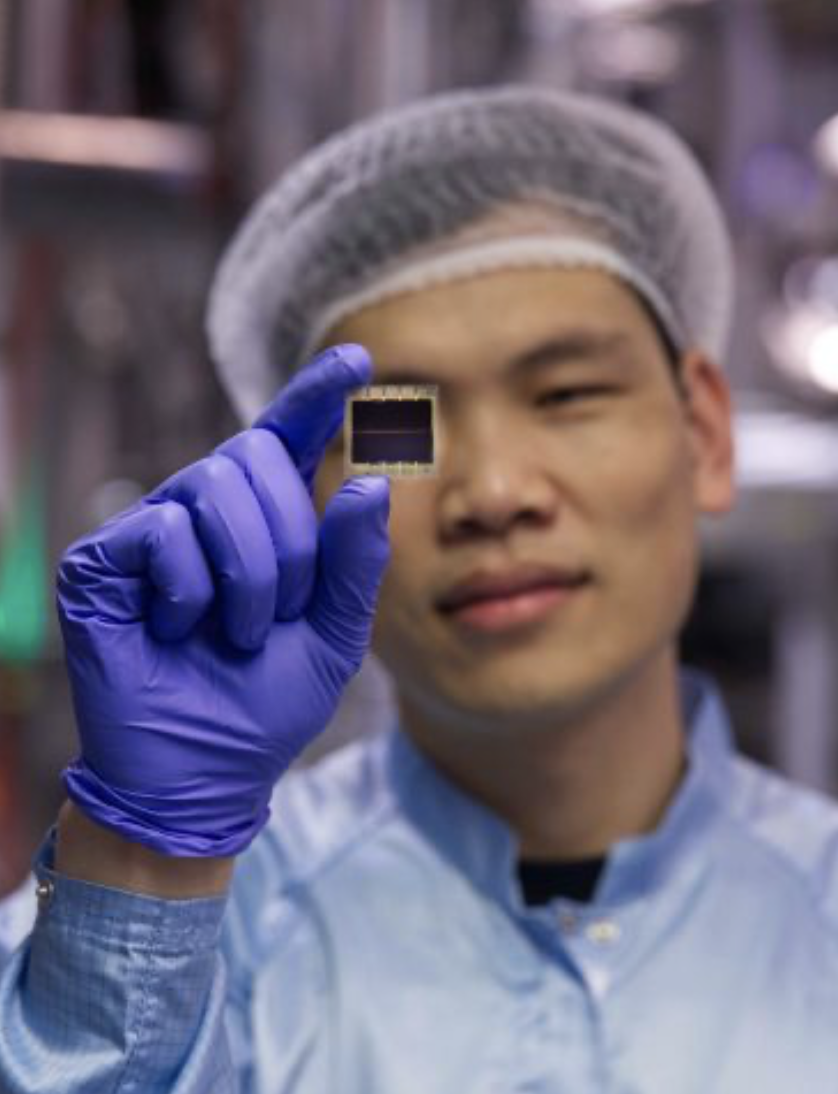
The idea of generating solar from everyday objects is nothing new. Researchers from Singapore's Nanyang Technological University debuted a thin solar cell that doubled as a touchscreen a decade ago. Bringing it into the real world proved challenging, but new developments could change that.
The key to this ultra-thin solar material is a relatively inexpensive mineral called perovskite, composed of calcium and titanium, and Oxford's isn't the only research team experimenting with it. Researchers at the City University of Hong Kong also unveiled a perovskite solar material this month which they say is essentially printable for inexpensive production on a mass scale, just like "printing newspapers," said Alex Jen Kwanyue, chair of the university's materials science department.
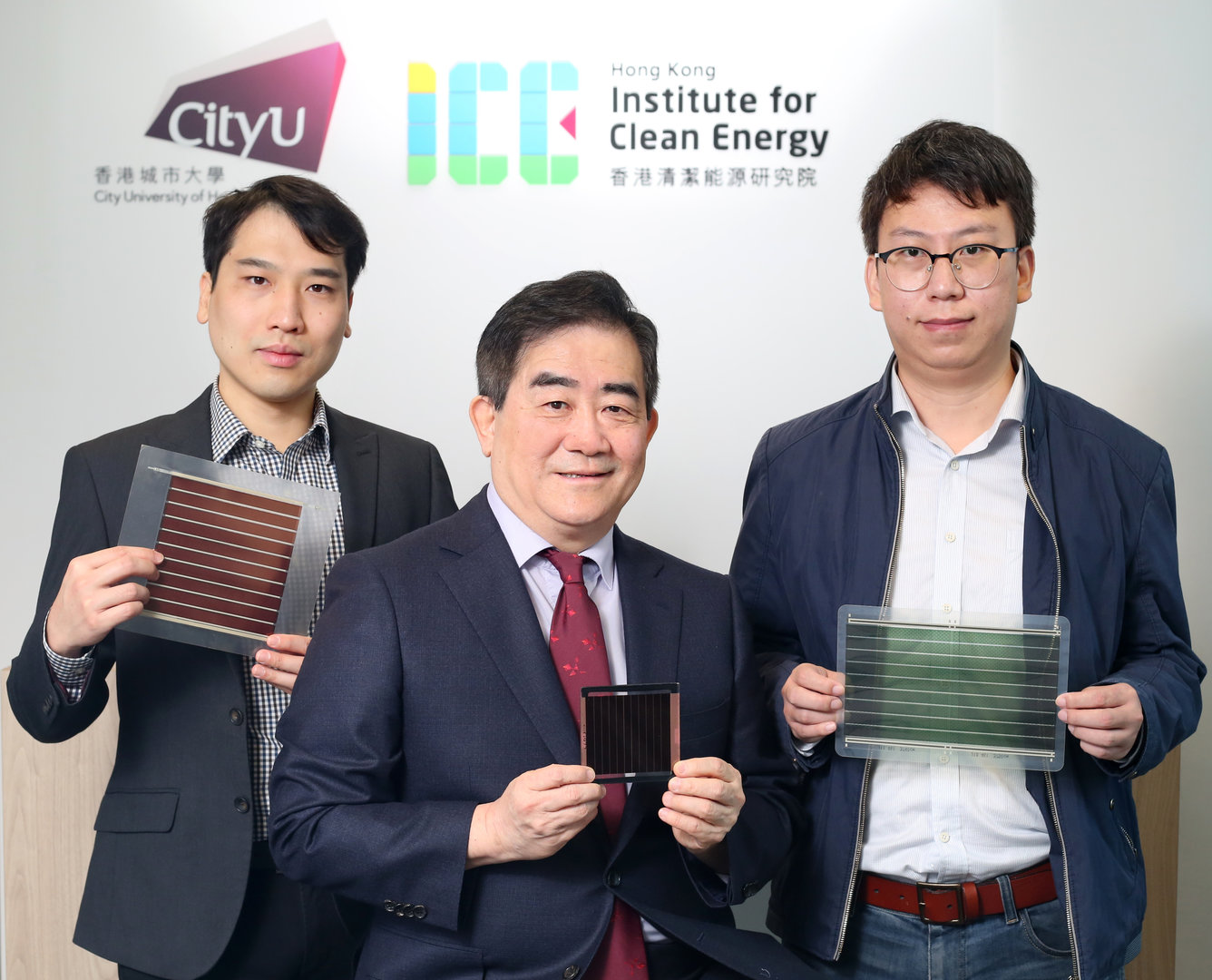
Importantly, both teams are reaching new heights in power conversion efficiency. The City University of Hong Kong's material reached around 26 percent efficiency in lab testing, which means it converts 26 percent of the sunlight that hits it into energy. Oxford's surpassed 27 percent, nearing “the limits of what single-layer voltaics can achieve today," Shuaifeng Hu of the university's physics department said in a statement. "We believe that, over time, this approach could enable the photovoltaic devices to achieve far greater efficiencies, exceeding 45 percent," he said.
The research teams say innovations like these will continue to decrease the cost of solar, which is already 90 percent cheaper than it was in 2010, while opening new possibilities for solar development with less space.
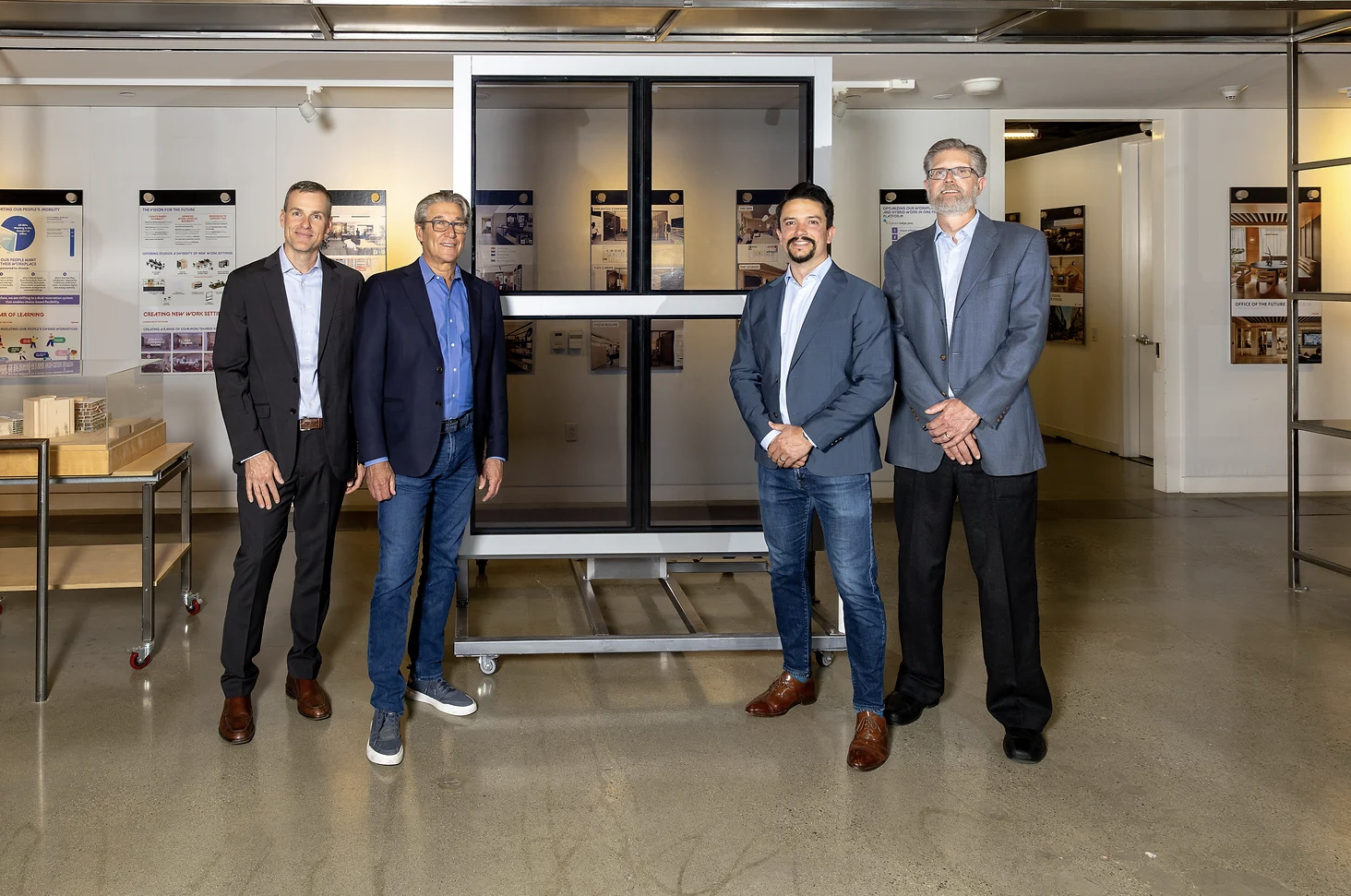
Solar windows take a major step toward the mainstream
Even as researchers reach new breakthroughs in developing ultra-thin solar film, maintaining the transparency of this material so it can be used on building windows is another matter.
The California startup Next Energy Technologies is among those looking to commercialize solar windows, and it installed a demo window at the design and architecture firm Gensler's headquarters in Los Angeles earlier this summer. At only around 6.5 square feet, the test window is small, but it carries big implications for a technology more than two decades in the making.
Rather than the silicon used in standard solar panels or the perovskite used in films, Next Energy coats glass with organic materials to generate energy from the sun. The organic semiconductors it uses today were first discovered at the University of California Santa Barbara, where the company was formed, earning the research team a Nobel Prize for Chemistry back in 2000.
The company says the test brings it one step closer to bringing a full-size solar window to the market. “It’s rewarding to see our technology developed to the point where commercialization can be realized and demonstrated to architects, glass fabricators and framing system providers,” CEO Brenton Taylor said in a statement. Gensler co-chairman Andy Cohen called the company's technology "an innovation breakthrough for architects that will transform the game plan for sustainable buildings."
Two is better than one for solar thermal, with China's dual-tower plant boosting efficiency by 24 percent
Rather than flat panels that convert the sun's rays into energy, solar thermal setups include thousands of mirrors that reflect sunlight up to a tower. Magnifying the intensity of the sunlight creates high temperatures that produce steam which powers a turbine to create energy. Though these systems are actually more efficient than conventional solar panels, they tend to be more expensive and as such were slower to take off. That may soon change as recent innovations boost efficiency even further.
China is almost finished with a dual-tower solar thermal installation it says can achieve record performance. The new plant in Gansu Province incudes two 650-foot towers surrounded by around 30,000 mirrors. When it comes online later this year, it's expected to generate more than 1.8 billion kilowatt-hours of electricity per year, enough to power over 100,000 homes.
The big change in the plant's design comes down to the placement of the mirrors, says project manager Wen Jianghong. "The mirrors in the overlapping area can be utilized by either tower," he told New Atlas. "This configuration is expected to enhance efficiency by 24 percent." Energy produced by the plant is expected to avoid 1.53 million tons of carbon dioxide emissions annually, the outlet reports.
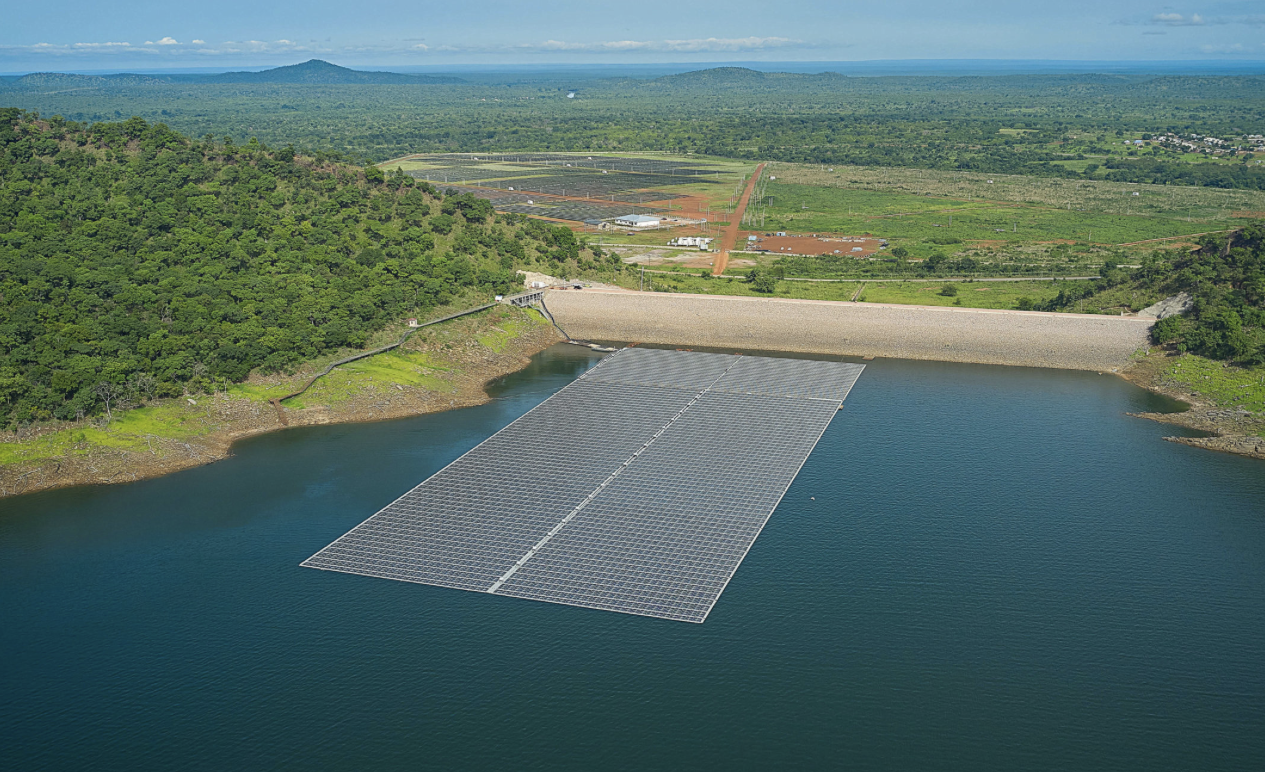
Floating solar panels could provide much of Africa’s energy, research finds
Floating solar panels are promising for countries without a lot of extra land, and they come with the added benefit of reducing water evaporation from at-risk lakes and reservoirs. Though less than 5 gigawatts worth of floating solar is installed worldwide, compared to more than 1,000 gigawatts of land-based solar, the technology's potential is vast. One piece of 2023 research estimated 35,000 terawatt-hours of floating solar power potential off the coast of Indonesia alone, which is more than all the energy currently produced on Earth.
Another study released this year estimates the technology could help countries across Africa meet their energy needs with renewables. Ethiopia and Rwanda could generate more energy than they currently use by installing floating solar on just a portion of their available water surfaces, according to the analysis conducted by U.K. environmental scientists R. Iestyn Woolway and Alona Armstrong.
Other African countries including Chad, Mali, Madagascar, Malawi, Uganda, the Democratic Republic of Congo and Togo could meet between 15 percent and 73 percent of their energy needs with floating solar. "We also found that there are 1,977 water bodies across Africa that could be used to float solar panel systems," Woolway and Armstrong wrote in an op/ed for The Conversation.
African countries are clearly paying attention, with Ghana switching on the continent's largest floating solar system at a reservoir earlier this summer and Kenya inking plans to install more than 40 megawatts of floating solar at a network of hydropower plants.
New York City Takes Its Biggest Step Yet for Offshore Wind

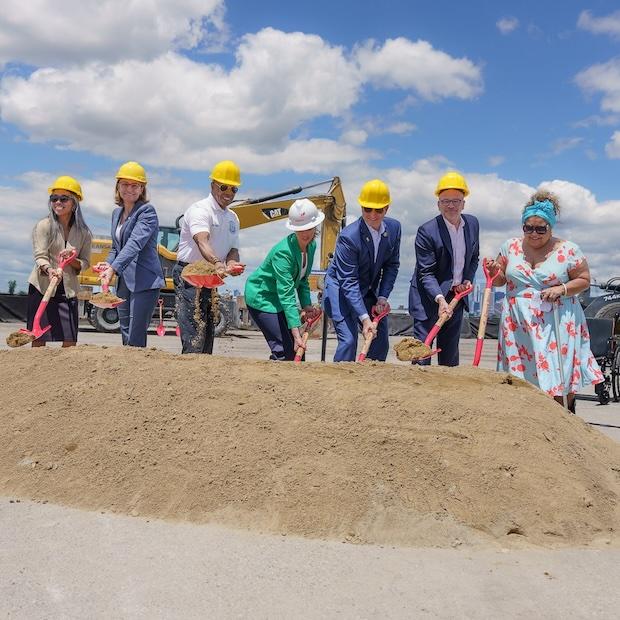
New York City Mayor Eric Adams (third from left) makes a clean energy- and job-related announcement at the South Brooklyn Marine Terminal at 39th Street & 2nd Avenue in Brooklyn, New York on June 10, 2024. (Image credit: Benny Polatseck/Mayoral Photography Office)
New York City will soon be home to one of the nation's largest offshore wind projects. In June, developers broke ground at the municipal South Brooklyn Marine Terminal (SBMT), an old container and general cargo port facility occupying 73 acres that will provide crucial services for Empire Wind 1, a federally approved offshore wind farm set to contribute 810 megawatts of clean electricity to New York’s power grid by 2027.
The groundbreaking builds on New York’s Green Economy Action Plan and Mayor Eric Adams’ efforts to develop a multifaceted “Harbor of the Future.” Both initiatives reimagine New York City’s waterfront and fuel 21st-century growth and innovation.
The newly imagined South Brooklyn Marine Terminal is poised to be far more than a support facility for wind energy. It will also play an important role in urban regeneration while providing important employment opportunities for union jobs paying family-sustaining wages.
”Transforming the South Brooklyn Marine Terminal into a hub for offshore wind is an investment in New York City’s economy on a generational scale,” said Molly Morris, president of Equinor, the company which will develop the Marine Terminal site and Empire Wind 1.
The terminal was last used by a car importer but sat derelict for over a decade. Back in 2015, New York City Economic Development Corporation (NYCEDC) put the site on the market “to figure out what could be feasible to bring new life to this parcel of land,” said Sam Jung, vice president of renewable energy industry development on NYCEDC’s Green Economy team.
In September 2021, the city and NYCEDC unveiled a 15-year, $191 million Offshore Wind Vision Plan to make New York a leading destination for the industry. To deliver on that vision, in March 2022 New York City Mayor Eric Adams announced an agreement between NYCEDC, Equinor, and Sustainable South Brooklyn Marine Terminal, L.P. (SSBMT) — a partnership between Industry City and the Red Hook Container Terminal — to transform the terminal into one of the largest offshore wind port facilities in the nation.
Leaders in the Sunset Park neighborhood, along with the Brooklyn-based environmental justice organization UPROSE, came together to put forward a community-based vision for the terminal and the community. The goal was to transform the area into a sustainable and green industrial waterfront. “The idea that it could be a wind port facility was really seen by them,” Jung said.
How do onshore terminals support offshore wind?
Most people are familiar with offshore wind farms, but the onshore component may be less obvious. The South Brooklyn Marine Terminal will serve as an onshore support hub, maintaining necessary functions both during the wind farm’s construction and on an ongoing basis for future operations.
The terminal will serve as an operations and maintenance center for the wind farm and as a staging and assembly area for wind turbine components. It will also host an electricity substation that will connect wind electricity generated offshore to the grid. “The lease for the site will go through 2054, demonstrating NYC’s commitment to the clean energy future,” Jung said.
The project will create more than 1,000 jobs during construction, 200 turbine assembly jobs, and approximately 50 permanent positions once the terminal is completed.
New jobs support community impact
Equinor aims to award 30 percent of project opportunities to minority- and women-owned businesses, and where possible, the build-out will draw upon labor from local neighborhoods and New York City more broadly.
Equinor signed a project labor agreement which prioritizes Sunset Park residents, New York City labor union members, and low- or very low-income New Yorkers for jobs at the terminal. “We are committed to creating opportunities for New Yorkers to secure well-paying careers in the growing renewable energy industry,” said Morris of Equinor.
Crews, many of them from women-owned businesses in the area, spent the first half of the summer taking down old buildings to make way for the planned terminal. As the site moves to the next stage, locals hired into union jobs will begin constructing the necessary infrastructure to support the waterfront project.
”There’s a lot of labor that goes into this. From the laborers to the carpenters, to the welders, to the dock builders, everybody works hand-in-hand,” said Kirt McCarthy, a 25-year veteran of the New York City District Council of Carpenters union. “As we go along, by months and quarters, it’s like a puzzle — it comes together in pieces. In my 25 years in the union, I’ve been at a lot of big sites and every one is different, so every day is a learning experience.”
Experienced workers like McCarthy are close by to help the younger apprentices, perpetuating an ongoing process of bringing up the next generation who will have access to family-sustaining wages through union work. “I feel this wind farm is going to grow roots in the neighborhood and the city,” McCarthy said. "The labor aspect of it is great, and I hope we can get some more projects like this in New York City.”
Jung of NYCEDC hopes the revitalization of the area will create a new walk-to-work community that will grow. “From the city’s perspective, we’re leveraging this moment to seed other investment in the area [and] make South Brooklyn a new center of gravity for other climate-related activities,” he said.
Public funding of the project has already garnered multiples in private investment. On the public side, the New York State Energy Research and Development Authority (NYSERDA) awarded a grant of $60 million to the project, augmented by $105 million in city capital. These investments leveraged $1 billion in private capital from Norway-based Equinor, an important injection of direct investment for the city. “We are proud to say that this combination of public funding is unlocking a ton of private value for New Yorkers,” Jung said.
Upskilling New Yorkers for offshore wind and maritime careers
The city also invested heavily to support workforce development and spread awareness of the career opportunities the terminal will bring about. That includes annual offshore wind and maritime career fairs, a more than $10 million investment in the local City University of New York (CUNY) system for workforce programing and facilities, and an emerging partnership with the Harbor School, a public high school on New York City’s Governors Island that focuses on maritime careers.
Students at the Harbor School will have a chance to see the city’s budding offshore wind sector take shape through an internship program with Edison Chouest Offshore, the company that will build and operate Equinor’s services operations vessel. The ship will be utilized in the operations and maintenance functions for Empire Wind 1 and will be home-ported at the South Brooklyn Marine Terminal.
“SUNY Maritime College’s Global Wind Organization training programs are collaboratively leading New York State’s energy transition by supporting the forward-looking, diverse and sustainable workforce of the future,” said James Spear, director of professional mariner training at the State University of New York’s Maritime College. “As part of the nation’s first maritime academy, we’re excited to help our fellow New Yorkers build an inclusive and efficient tomorrow.”
Meanwhile, city-supported Workforce One centers, including a location at NYCEDC’s Brooklyn Army Terminal (BAT) in Sunset Park, that aim to enroll everyday New Yorkers into pre-apprenticeship programs “so that people from all across New York, but particularly Sunset Park, can begin the process of getting into good-paying, family-sustaining union jobs, like Kirt is in,” Jung said.
Laying the groundwork for other cities to follow
The planned terminal also supports New York state’s climate goals which include generating 9 gigawatts of offshore wind electricity by 2035. “We are in lockstep with the state and federal government to realize these goals,” Jung said. “This redevelopment is in service of a more livable future for New Yorkers, and doing it in a way that supports those historically underserved and impacted communities from the fossil-fuel industry, so they can benefit from these renewable energy investments.”
Jung and his team at NYCEDC believe the terminal will serve as a model for how renewable energy development can promote minority- and women-owned businesses, forge partnerships with environmental justice groups, and trigger reinvestments that benefit the local community.
“At a localized scale, [the terminal] is set up to have a robust and long future,” Jung said. But success will ultimately depend upon factors that still hang in the balance.
The terminal is designed to host services for Empire Wind 1, but it is built with sufficient capacity to serve other wind farms, too. This means part of the terminal’s success will depend on ensuring a consistent and reliable pipeline for offshore wind developments in the future.
One thing which might impact that pipeline is confidence within the industry. “The industry looks to the public sector for reliability,” Jung said. “In an election year, there can be concern about what a change in administration might do to an emerging industry.” To this end, he said the city is doing as much as it can to enable the industry to succeed.
Over recent years, factors like high interest rates, higher commodity prices, supply chain constraints and even the war in Ukraine also manifested as unforeseen barriers.
Even still, the transition from a derelict piece of land to the South Brooklyn Marine Terminal is an important and optimistic one. “As the offshore wind industry continues to grow, it is critically important to continue developing a highly skilled workforce and pathways to family-sustaining union careers for New Yorkers interested in entering the industry,” said Gary LaBarbera, president of the Building and Construction Trades Council of Greater New York. “Our members are proud to be working on the redevelopment of the South Brooklyn Marine Terminal.”
Kirt McCarthy of the District Council of Carpenters agreed. “I hope this could be the beginning of many more successful projects like this one that will help the city and help the community, and I’m thankful.”
Innovators Look to Overcome the Limits of Geothermal Energy in the U.S.
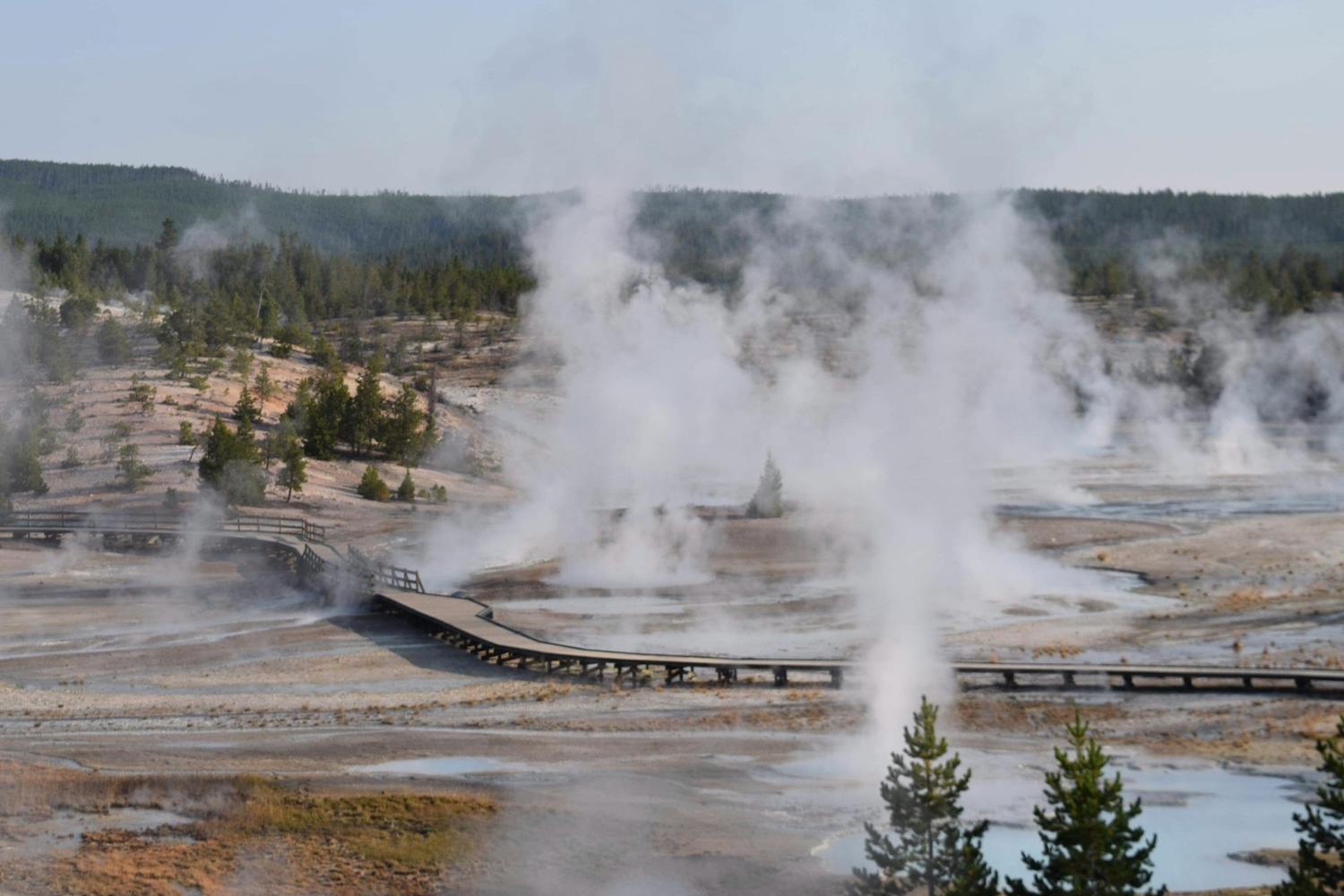
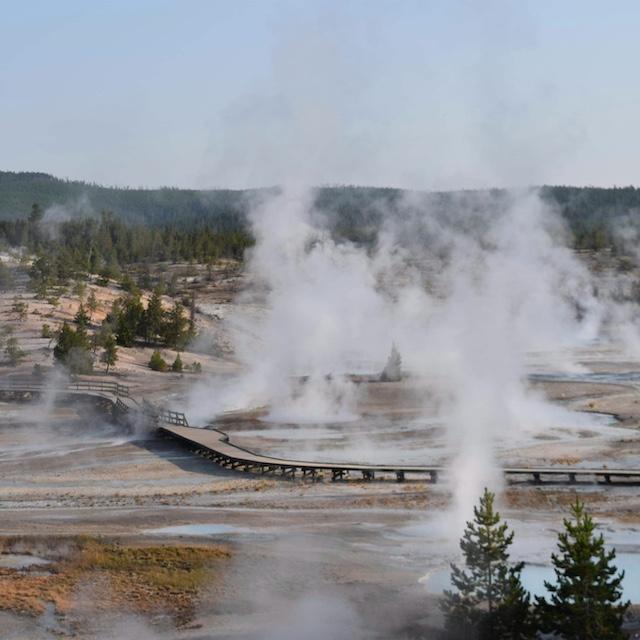
Steam rises up from Norris Geyser Basin in Yellowstone National Park as water is heated underground, a natural example of geothermal energy. (Image: Noémie Cauchon/Unsplash)
An important clean power resource lies beneath the surface of the Earth in the form of geothermal energy. Access to geothermal energy in the United States was limited to naturally occurring hotspots in the West. Now, the Biden-Harris administration is leveraging technology from the oil and gas industry to open access to geothermal energy to a wider field, including the Eastern U.S.
The limitations of geothermal energy
In contrast to wind turbines and solar panels, geothermal resources can generate electricity on a steady, 24/7 basis, just like a conventional fossil energy or nuclear power plant. With this level of performance, the geothermal industry could play a key role in the U.S. renewable energy profile. But geologic conditions have limited its reach.
Virtually all of the geothermal power plants in the country are located in California and other parts of the West, according to the U.S. Energy Information Agency. In these regions, geothermal resources are naturally located close to the surface and can be accessed with conventional technology.
“Natural geothermal systems exist in the presence of heat, permeability and fluid underground,” according to the agency.
One standout example is The Geysers, an 18-plant geothermal complex in California. The facility was first commissioned in 1960 and remains the largest geothermal complex in the world.
A helping hand from the oil and gas industry
Currently, geothermal power plants account for just 4 gigawatts of electricity in the U.S. But next-generation, cost-effective technologies could increase that number to 90 gigawatts, according to the U.S. Department of Energy.
To open up other parts of the country for geothermal production, the Department of Energy enlisted hydrofracturing technology, also known as fracking, to create artificial geothermal reservoirs called Enhanced Geothermal Systems (EGS).
Hydrofracturing involves pumping water and sand underground at high pressure to extract oil and gas from shale formations. It was linked to a wide range of public health risks and environmental hazards after coming into widespread use during the early 2000s.
Those impacts are not relevant when the process is used for geothermal development. For EGS, hydrofracturing opens up existing subsurface fractures, creates new ones or both. That process allows more fluid to circulate through the hot rock underground, according to the Department of Energy. The fluid brings heat to the surface so it can be used to generate clean, renewable electricity with existing technology.
“The ability to tap geothermal resources for electricity requires subsurface heat, water or fluid, and permeability (ability for fluid to flow through rock),” Kevin Jones, manager of the Department of Energy’s Frontier Observatory for Research in Geothermal Energy, told TriplePundit in an email. “Where those components do not exist naturally, such as in the Eastern United States, enhanced geothermal systems (EGS) can be used to create human-made geothermal reservoirs.”
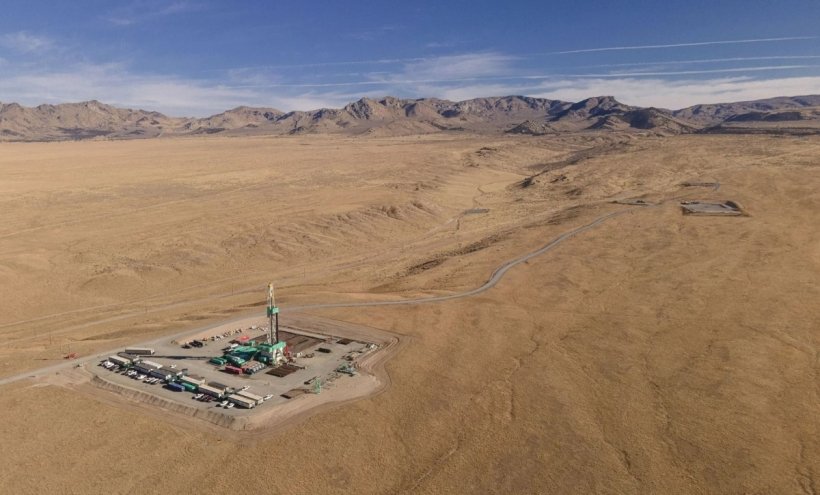
An assist from the 2021 Bipartisan Infrastructure Law, too
Although hydraulic fracturing is a mature technology, its use in the geothermal industry is new and costs are relatively high. The Biden-Harris administration is supporting new, cost-cutting EGS innovations through the Enhanced Geothermal Shot program. It aims to foster a 90 percent drop in the cost of EGS by 2035, bringing it down to $45 per megawatt-hour.
Funding from the 2021 Bipartisan Infrastructure Law also provided a financial platform for EGS innovators. The law specifies that funding be provided to projects that increase production at or near existing geothermal fields in the West, expand EGS into other regions where sufficient heat is present, or demonstrate the technology in the Eastern U.S.
First steps to another new sustainable energy industry
So far, the Department of Energy’s Geothermal Technologies Office has awarded $60 million in Bipartisan Infrastructure Law funding to three pilot projects in the Western U.S. The awardees — Chevron New Energies, Fervo Energy and Mazama Energy — will demonstrate new EGS technologies in California, Utah and Oregon.
The office is now selecting awardees to share up to $14.2 million in additional funding for EGS pilot projects in the Eastern U.S. As with the first three projects, the new cohort is expected to demonstrate a variety of advanced EGS technologies, while serving as platforms for experimentation and models for best practices.
The awardees will also demonstrate how consumers and markets contribute to the design of EGS projects, particularly regarding the equity and environmental justice goals of the Biden-Harris administration. Applicants are required to submit a plan describing how they will ensure the federal funding advances energy equity, investment in America's workforce, and diversity, equity, inclusion and accessibility, Jones told 3p.
The EGS initiative is part of an overarching goal to ensure that the renewable energy transition does not overlook frontline communities that have long been burdened by the impacts of conventional energy development, Jones said. That includes creating new employment opportunities for fossil energy workers displaced by decarbonization.
“Geothermal energy also shares numerous other similarities with oil and gas, including drilling technologies, workforce skills, and subsurface exploration techniques,” Jones said.
Technology obstacles aside, the next steps will also need to address the slow pace of permitting for energy projects. Nevertheless, the Department of Energy's estimate that new geothermal technologies could bring the country’s capacity up to 90 megawatts is a timely reminder that the nation has only just begun to tap into its renewable energy resources.
‘It Takes a Team.’ How Action Sports Empower Combat Veterans When They Return Home


The nonprofit Warrior Built enters all-veteran teams into off-road motorsport races, including the Score International Baja 1000 in the Baja Peninsula of Mexico, with Monster Energy as the lead sponsor. (Image courtesy of Warrior Built)
Even after serving in the United States Marine Corps for 20 years, Nick Hamm still answers the call of duty.
The call he answers today is not to take arms, but instead to help fellow veterans readjust to civilian life after experiencing combat. Hamm founded the Warrior Built Foundation, a nonprofit based in Lake Elsinore, California, that provides combat veterans with vocational training, recreational therapy and mental health services.
“Everything we do as far as the recreational stuff, the vocational stuff, benefits these veterans in many different ways,” Hamm said. “I would say the most powerful way is the relationships they create with each other.”
The veterans who come to Warrior Built have different backgrounds and served in different branches of the armed forces, but they share similar experiences in uniform. “They’re meeting people with similar struggles, so they’re helping each other,” Hamm explained.
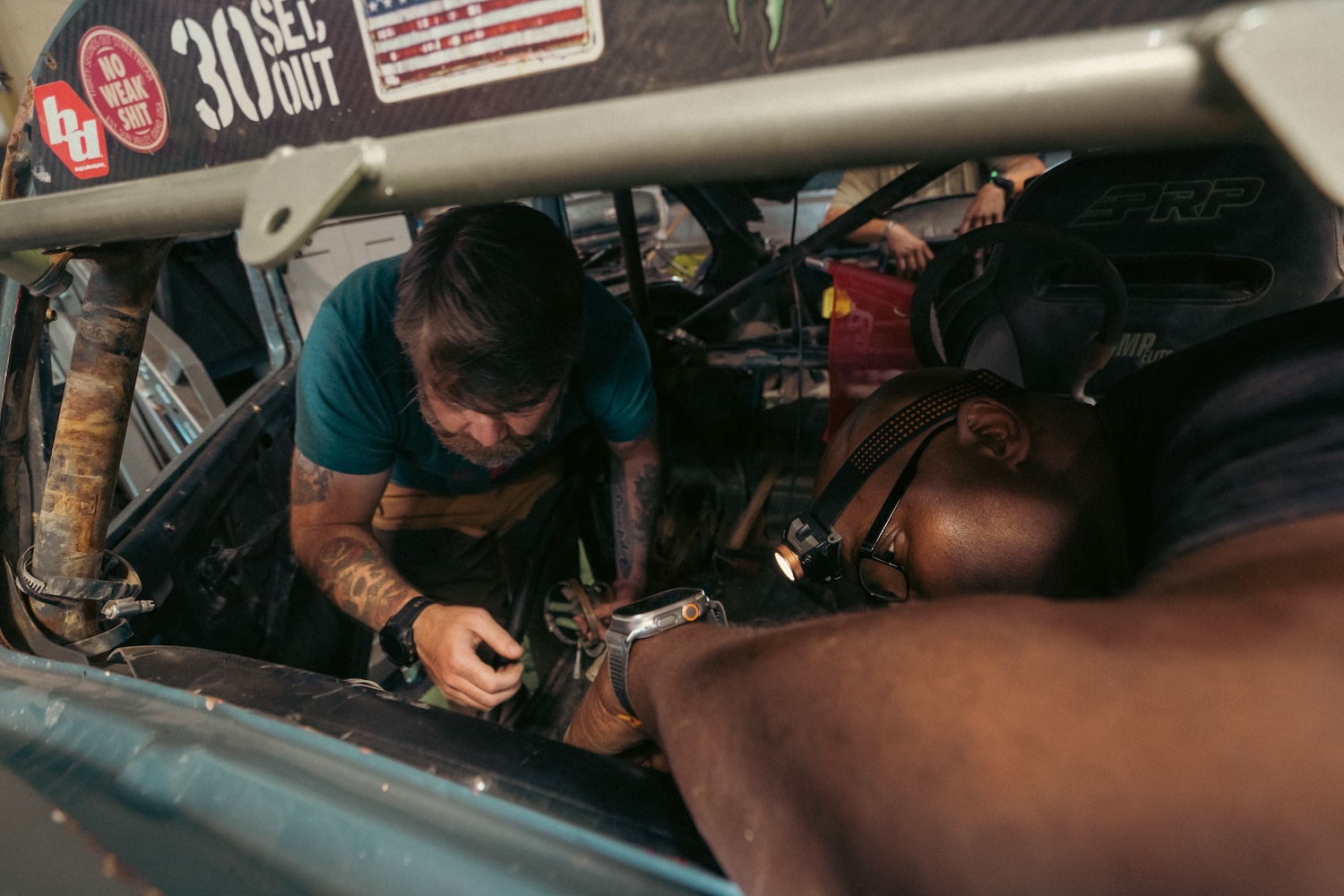
At the center of the organization’s mission is vocational training that exposes veterans to auto mechanics and mechanical fabrication for different types of motor vehicles. The veterans have free access to tools and equipment at Warrior Built to explore their interests and hone their skills.
“Whether it is an off-road vehicle, race car, classic car or motorcycle, we give them a chance to figure out if they want a future in the fabrication and mechanic industry or just do it as a hobby,” Hamm said.
Warrior Built’s operations depend solely on financial support from individuals, small businesses and corporations. For more than a decade, one of the nonprofit’s key supporters has been Monster Energy.
Monster Energy directly funds a facility for Warrior Built with a full-time instructor in general auto mechanics and welding, along with a gym, music room and computer room. Warrior Built also enters all-veteran teams into off-road motorsport races, the biggest of which is the Score International Baja 1000 in the Baja Peninsula of Mexico, and Monster is the race crew’s lead sponsor.
“Monster ensures that we have the financial capabilities to make sure that we’re not having to worry about paying our rent every month, that we’re not having to worry about some of the little things that normally we’d have to worry about,” Hamm said. “They allow us to focus on our mission.”
Beyond auto mechanics, Warrior Built’s recreational therapy involves engaging combat veterans in activities that boost their motivation and adrenaline, Hamm said. Along with bringing veterans together to compete in action sports, the nonprofit organizes trips to events like dirt bike races, drag racing, off-road racing and concerts.
“The main reason I chose off-road racing is because it takes a team,” Hamm said. “And obviously, in the military, we do everything in a team. Whether it’s your fire team, your squad, your platoon, your company, your battalion, it’s all a team. It’s not just one individual.”
He sees organizing off-road races as akin to a military operation because it involves planning, logistics, communications, and what he calls the “Five Ws” — who, what, where, when and why.
“We’re talking about making sure we’re loading everything up, and we’re convoying down to another country,” he explained. “We’ve got to stay together. We've got to look out for each other. Then during the race, everyone has a job. It’s not just the driver, co-driver or the guy riding. It’s the pit crew as well.”
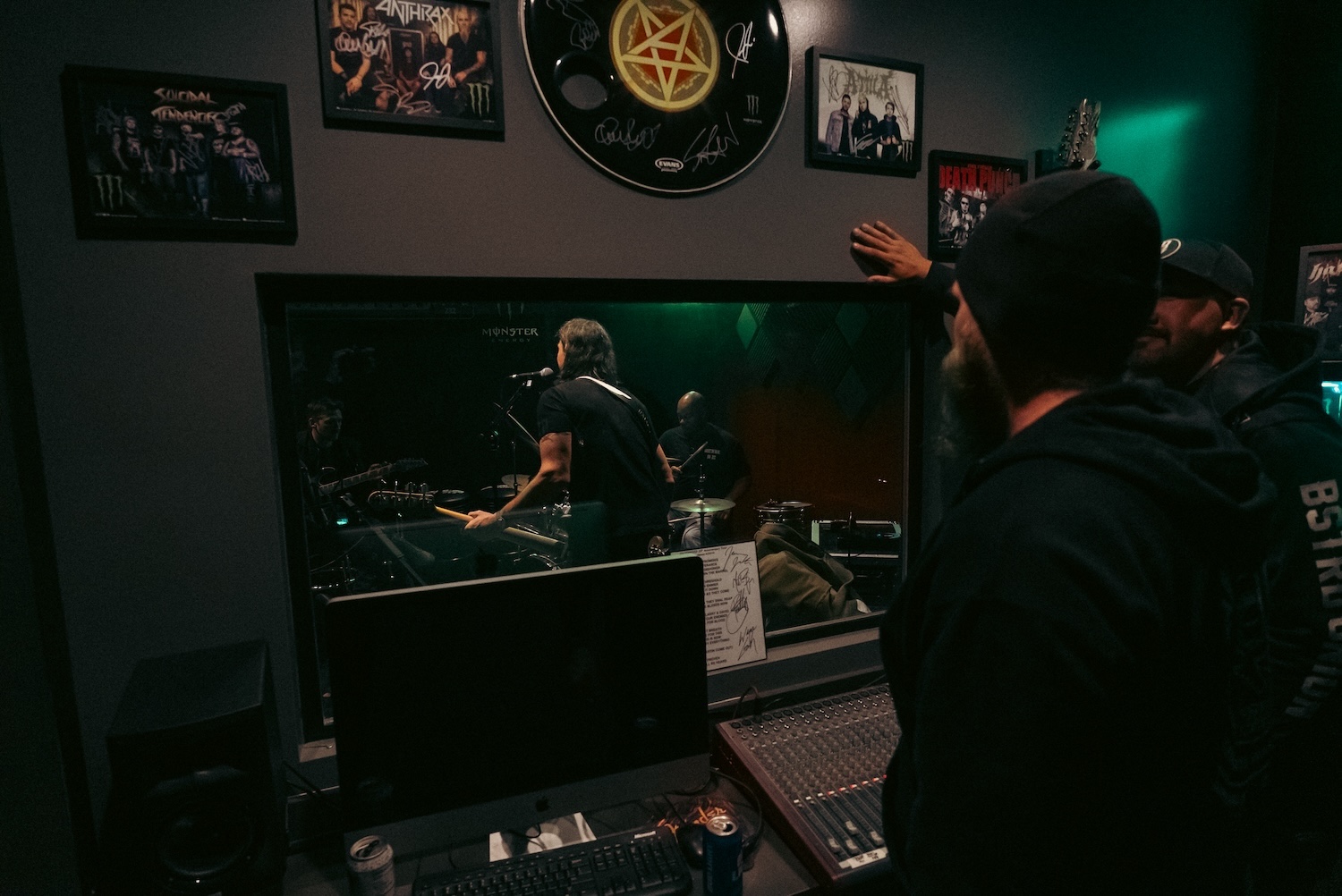
Warrior Built’s biggest challenge is outreach, both for getting more combat veterans involved and in raising funds, Hamm said.
“The charity world is very competitive, and there’s so many great charities out there helping veterans,” he told us. “I’m thankful that there’s so many great charities out there, but it also makes it challenging to compete for those donor dollars.”
Without the financial support from partners like Monster, Warrior Built could not operate at its current levels, he said.
“There’s no way we could have helped as many combat veterans as we have already, and there’s no way that we could do all these events and activities without them supporting us,” Hamm said. “Monster has helped us through in more ways than I think the public will ever know because of their genuine support for the military and their motivation to help us make a difference.”
This article series is sponsored by Monster Energy and produced by the TriplePundit editorial team.
A Firewood Lot is Helping This Timber Town Recover
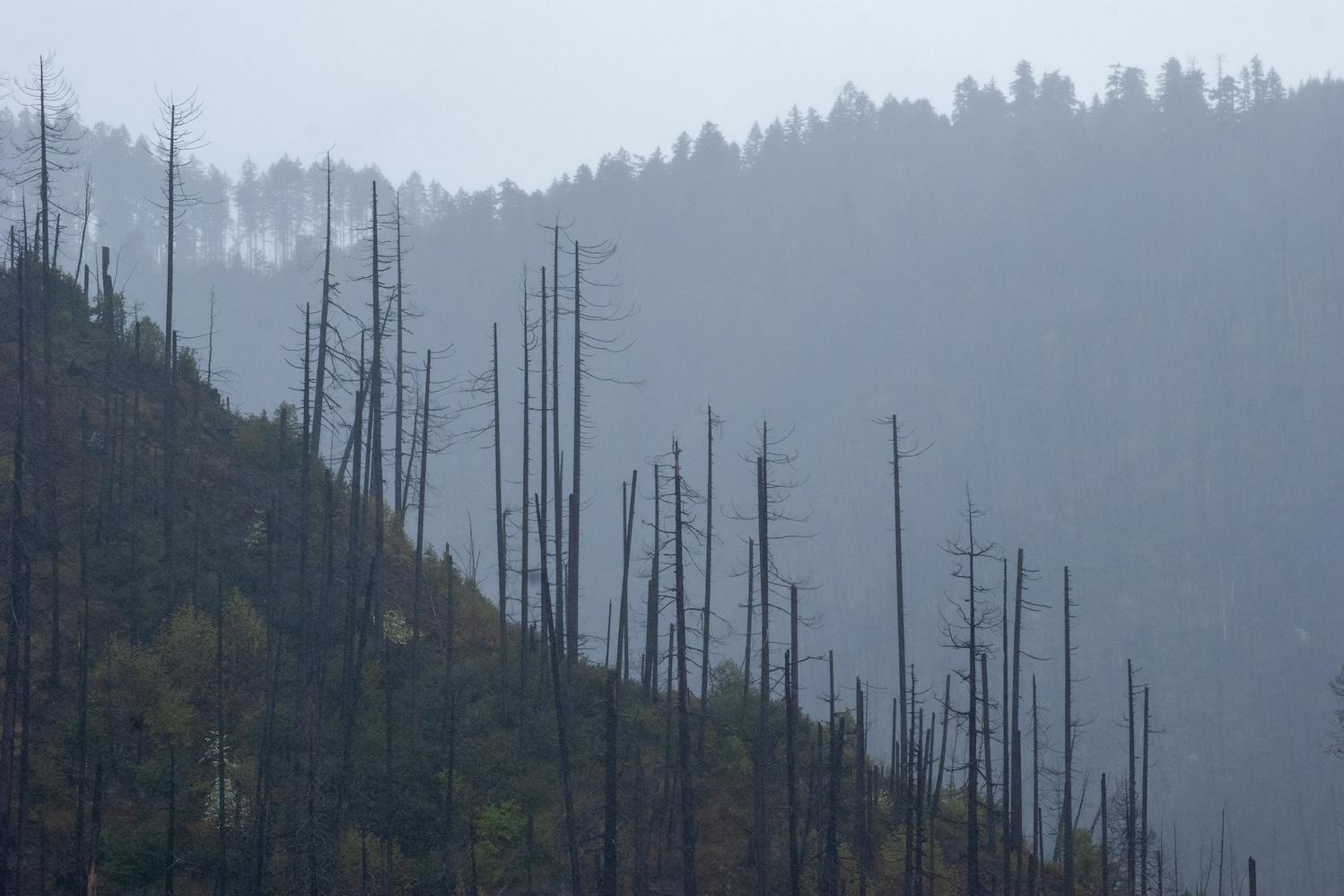
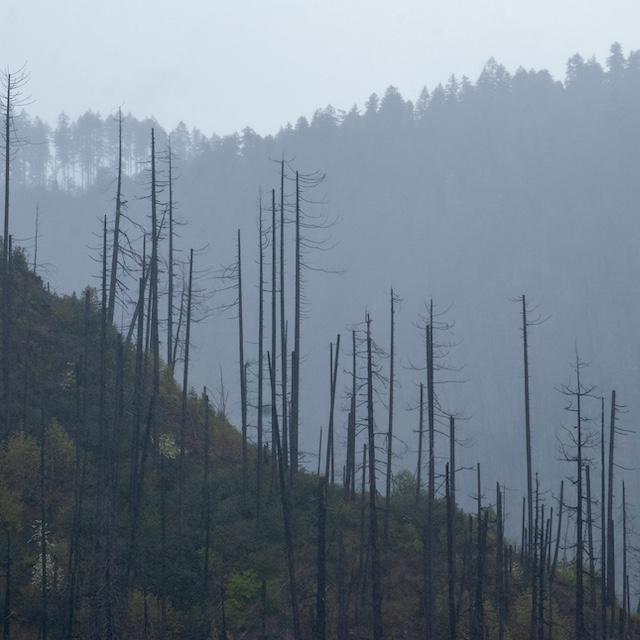
Trees left with burn scars years after a wildfire in Oregon's Cascade Mountain Range. (Image: Ashli Blow)
Driving down a gravel mountain road, Brock Buchmeier hauls a truckload of wood salvaged largely from forest fires. He brings a mixture of felled trees like cedar, oak and fir to an industrial park in Oakridge, Oregon, a small city just above the snow line.
“It’s a sketchy job, but someone has to do it,” Buchmeier said. “I’m doing anywhere between three to four trips a day to get this wood to the lot.”
His business, Brock’s Wood Lot, is the first in an emerging regional forest resource hub that could revolutionize how leftover debris from wildfires and logging are processed in this once-booming timber town.
The lot is one of 171 projects funded in part by a U.S. Department of Agriculture wood innovation grant program that creates new markets in rural communities while trying to manage wildfire risks. These nationwide projects share similarities, but each comes with its own set of challenges unique to the region.
For Oakridge, a smokey problem lies within its basin-shaped valley that traps pollutants in the air. Buchmeier and community partners are trying to solve it while living with wildfires.
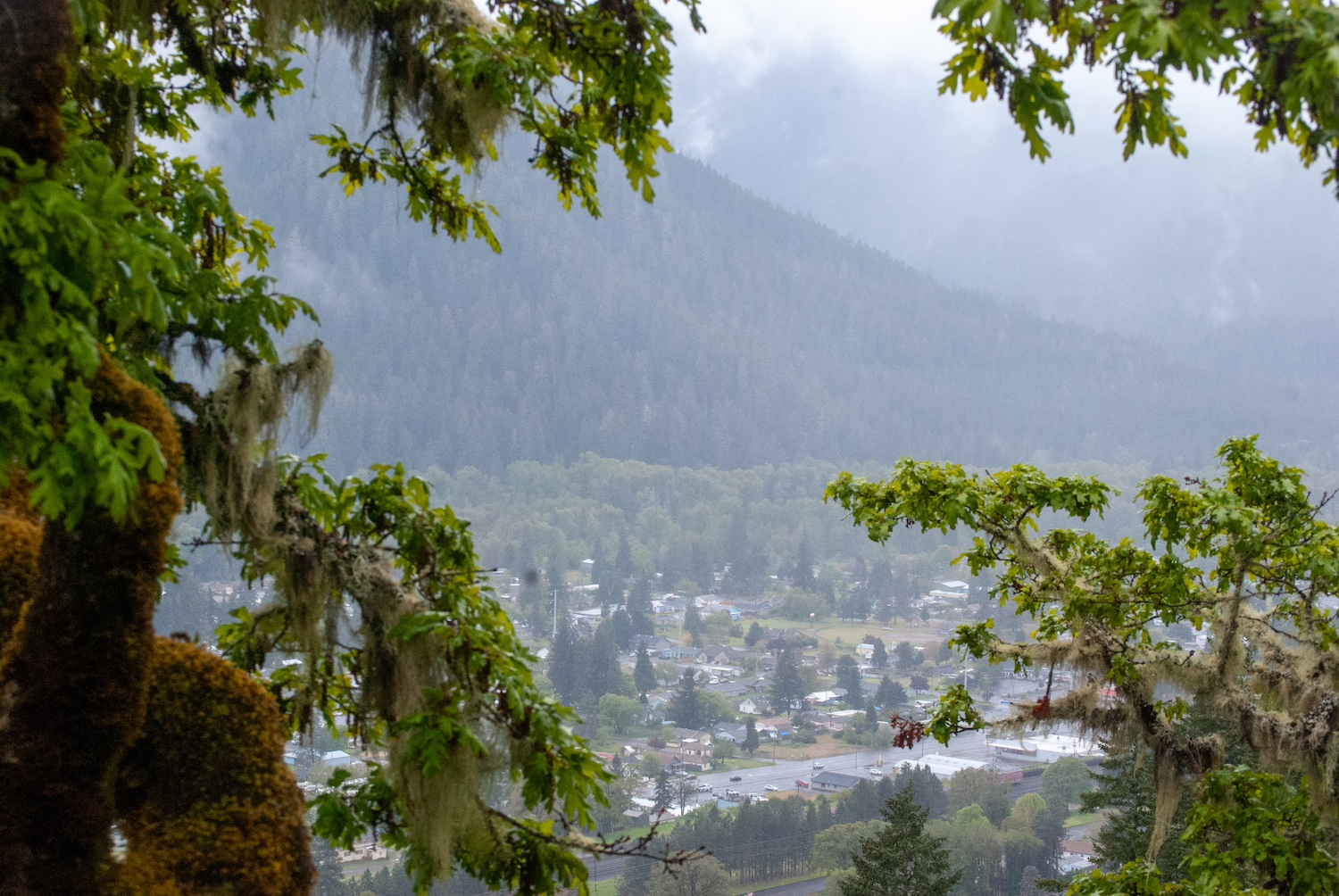
Using the unusable
This August, the Willamette Complex Fire, composed of several wildfires, burns outside of Oakridge. Its smoke brings high concentrations of particulate matter that can linger for months. And the residents there won’t have much of a reprieve come winter when more smoke follows from wood stoves, as most use them as their primary heat source.
It’s been a public health issue for years. So in response, the community started with their own homes.
But their transition to cleaner energy couldn’t exclusively turn to electric solutions like heat pumps. People in Oakridge tried it, installing free heat pumps from weatherization-adjacent programs. They became unreliable for a forest community with vulnerable infrastructure.
“After several years of living through power outages and not having heat for their homes, they took them out and went back to wood stoves,” said Sarah Altemus-Pope, executive director of the Southern Willamette Forest Collaborative. The group facilitates community-led decisions and secures funding for its plans by working with government departments, including the United States Environmental Protection Agency (EPA).
“If we were going to ask the EPA to invest millions in this community to upgrade wood stoves, then we really had to argue with the EPA, ‘Let us build a program that is going to guarantee dry wood,’ because that’s a missing piece,” she said.

For fuel, people burned wet wood, which produces denser and more toxic smoke than burning dry wood. But their options were limited. Cutting restrictions kept them from collecting wood in forests, and they didn’t have a vendor to buy from. They turned to buying wood out of the back of people’s trucks, where Buchmeier once sold his own bundles.
“It seemed that we could never cut enough wood,” he said. “There’s always a demand for firewood. So I bumped into Sarah, who said, ‘There’s this opportunity for a community firewood program.’ And I put one foot in front of the other.”
Altemus-Pope, who worked as a wildland firefighter, wanted to take it a step further. Not only could the program address wet wood, it could also reduce the woody debris that make fires burn exceptionally large and hot.
In the neighboring forests, bonfire-like piles of debris were stacking up. Some of this came from wildfire crews cutting trees to safely access and put out fires, while some came from loggers sorting through the unprofitable pieces of their harvest.
The forest service usually burns these piles under federal guidelines, but the process was another smoke source. So, Altemus-Pope and Buchmeier partnered with their local district to salvage them. After securing grants through the EPA, the U.S. Department of Agriculture, and local conservation districts, they acquired the equipment they needed to get started.
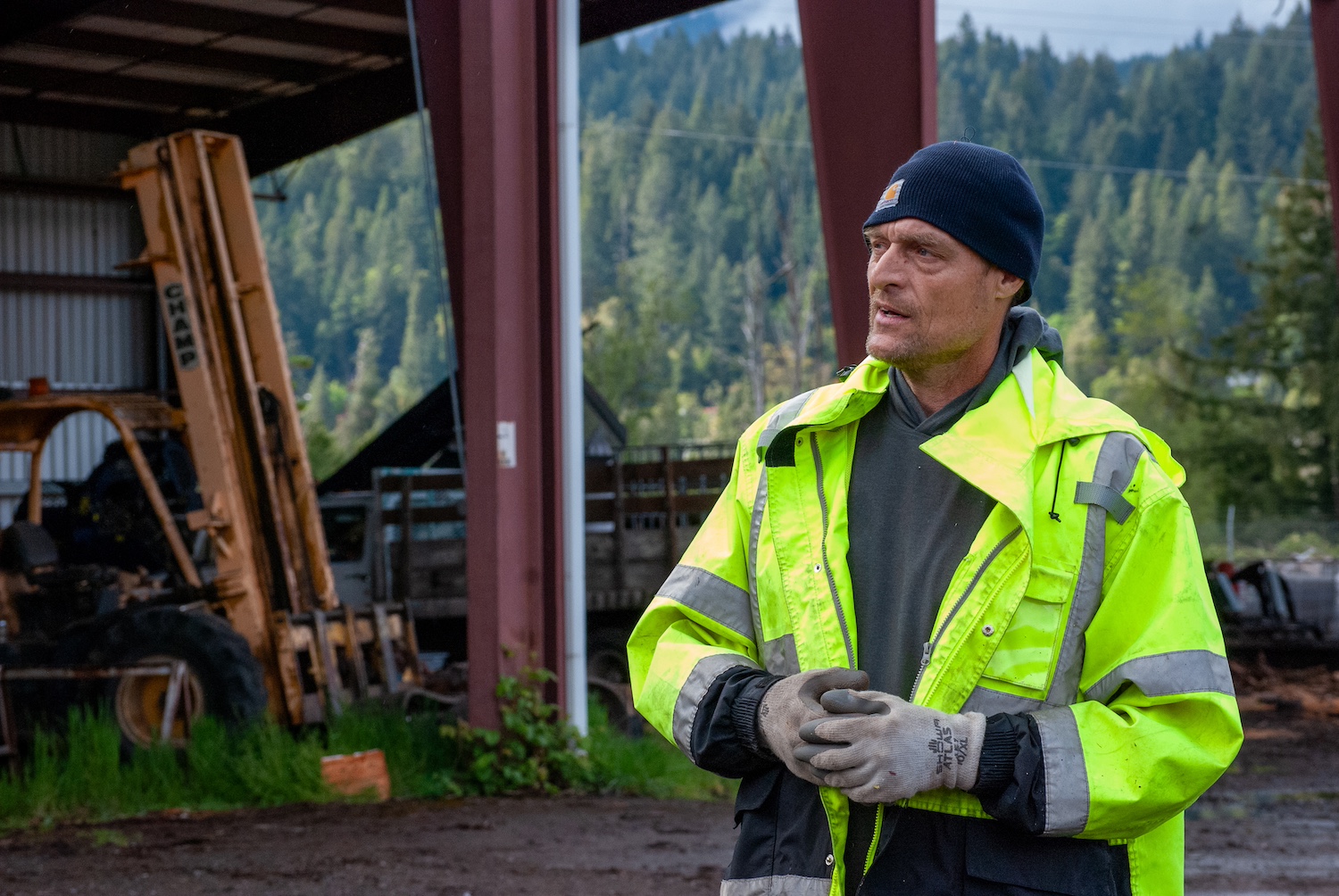
Doubling down
After trucking loads of treetops, branches and other vegetation from the forest to his lot, Buchmeier sorts them by species and moisture content. He then methodically dries them in a kiln powered by lower-quality wood from the piles.
In the last year, the community firewood program collected 200 cords, an industry measurement for stacks of wood that measure four feet high and four feet wide. It plans to double that this year with two new employees to help with the workload.
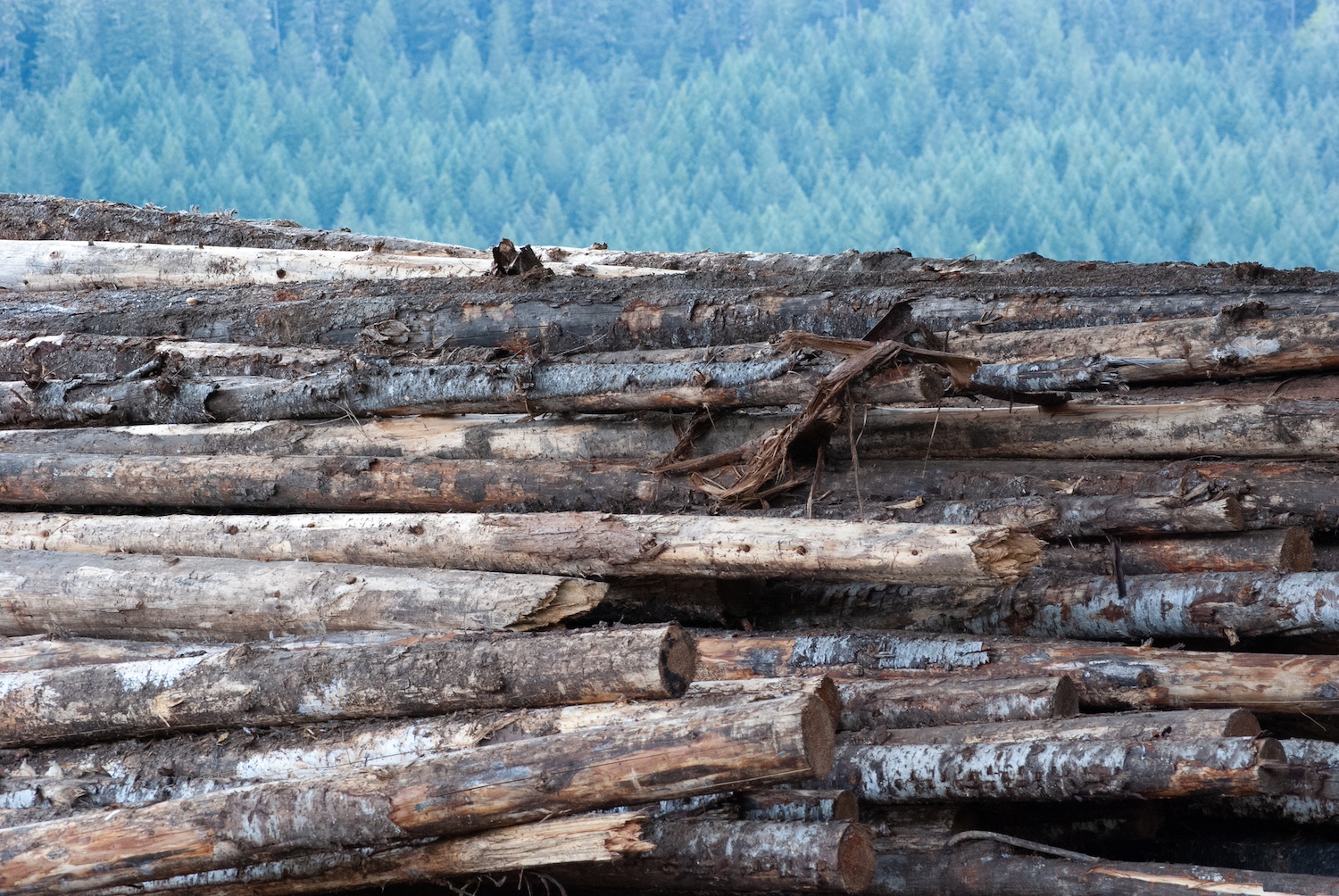
The goal is for the lot to be a launchpad for a wood resource hub that supports multiple businesses in one location, creating diverse products — from firewood to biochar — while sharing costs and materials. Right now, the margins for the wood lot are slim.
“I get calls all the time about, ‘Hey, we want to create a community partner program like yours,’" Altemus-Pope said. “It’s just not something anyone can do … It’s really expensive.”
The cost of operation is twice as much as what’s earned selling the firewood to city-subsidized buyers — a large portion of their customers who have low incomes, have a disability or are over 65 years old. To help cover the program costs, Buchmeier expanded to commercial sales, supplying firewood to hundreds of campgrounds throughout the Pacific Northwest.
But the business' primary focus is community service, not its bottom line.
“That’s what’s unique about this community, but I do think these lessons learned can be absolutely translated to other and bigger communities,” said Altemus-Pope, referring to leveraging the intersection of grants and natural resources.
Recently, millions of dollars were funneled from the federal wood innovation grant program to support wood processing facilities at the heart of small rural towns, including Buchmeier’s business. Wood processing was at the center of Oakridge for decades until its last timber mill closed in the 1980s. Reversing the economic damage doesn’t just take community innovation, it takes money.
“These investments will support good paying jobs for families and communities,” Xochitl Torres Small, U.S. deputy secretary of agriculture, said in a statement. “It will increase the economy’s capacity to manufacture wood products. In turn, sustainably sourcing the wood used to manufacture these products will make our forests healthier and reduce the threat of catastrophic wildfires.”
That’s what is starting to happen at the Oakridge community firewood lot, one truckload at a time.
Reporting for this story was made possible with a fellowship from the nonprofit Institute for Journalism and Natural Resources.
Reading Glasses Increase Earnings in Low-Income Communities


(Image: MontyLov/Unsplash)
People in low-income communities increased their earnings by up to 33 percent after receiving reading glasses, according to a new study. It found that the glasses improve livelihoods and quality of life while reducing poverty.
The research, called THRIVE (Tradespeople and Hand-workers Rural Initiative for a Vision-enhanced Economy), was conducted by the social enterprise VisionSpring, the Bangladesh-based international development organization BRAC and Queen’s University Belfast.
“We have always understood that with glasses, it’s not about the glasses, it’s about everything that comes afterwards,” VisionSpring CEO Ella Gudwin told TriplePundit. “It’s about earning, learning, safety and wellbeing ... We can intuit that our functioning, productivity, and income are impacted if we don’t have eyeglasses. And the same is true for people who are in low-income settings.”
The THRIVE trial included 824 people, with an average age of 47, across Bangladesh communities engaged in farming and artisan crafts. Some participants were teachers, tailors, shopkeepers and mechanics.
“Tailors will tell you they lose their customers because their stitches and hems aren’t straight, or they’re constantly relying on somebody else to thread their needle,” Gudwin said. “If you’re a farmer, you’re looking at your mobile phone to look at the weather reports, or to transact in the marketplace because many, if not most, farmers now are using mobile banking platforms. They have to be able to look at the quality of their seeds. They have to be able to identify pests, and they have to be able to read pesticide instructions. There are lots of tasks that enable somebody to be able to do their job with greater precision and accuracy if they’re wearing glasses that ultimately leads to an income boost.”
The root of the problem is presbyopia, the natural, gradual loss of the eye’s ability to focus as people grow older. It’s present in more than 1 billion people globally. Of the 35- to 65-year-olds tested for trial, 50 percent had presbyopia, demonstrating the potential to benefit a large, important group with an inexpensive intervention.
“[Presbyopia] is a hidden problem in the health sector because it doesn’t kill anybody, and so it doesn't have an urgency on it,” Gudwin said. “VisionSpring, from the beginning, has always understood eyeglasses as a livelihoods intervention. We were founded on the idea that a billion people need glasses globally, and more than 800 million of them just need over-the-counter reading glasses, just need magnifying glasses.”
This lack of urgency can be addressed with lower-level health workers, she said. All the vision tests in the trial were conducted by non-medical personnel and the reading glasses were dispensed by community health workers, proving that this approach can work. Last year, the World Health Organization started using the same method.
Participants experienced a number of benefits on top of increased earnings. Some of those who were not working returned to work and participants’ sense of independence and ability to do daily tasks improved. And they didn’t need to be able to read to reap these benefits — 35 percent of the people participating were literate.
“The findings of the THRIVE study demonstrate the power of reading glasses in helping reduce poverty,” Nathan Congdon, the Ulverscroft chair of global eye health at Queen’s University Belfast, said in a statement. “For the cost of only a few dollars a pair, reading glasses have a significant and sustained impact on an individual's earnings and help others get back into work. Where people are vulnerable to poverty, we can have an immediate and dramatic impact on livelihoods through this extremely simple and cost-effective intervention.”
Homepage image: Caleb Woods/Unsplash
Can Digital Twins and Tree Mapping Help Cities Adapt to Climate Change?
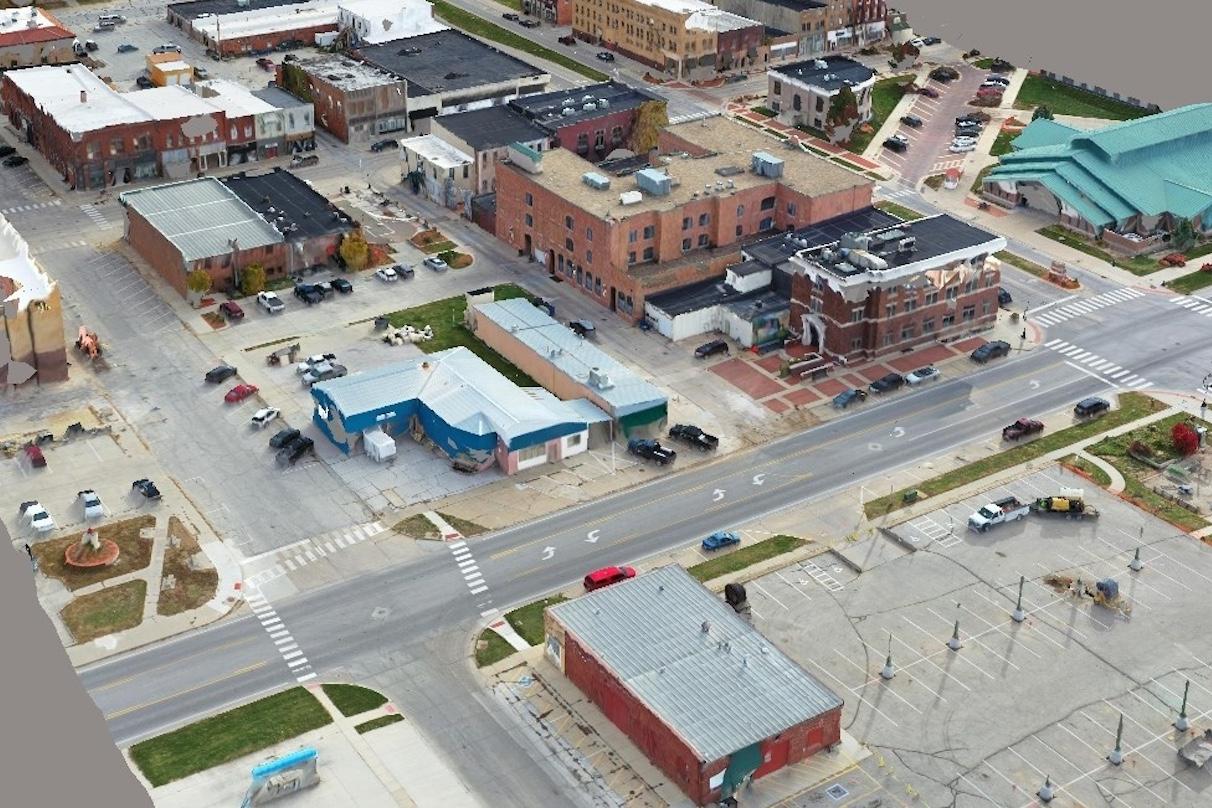
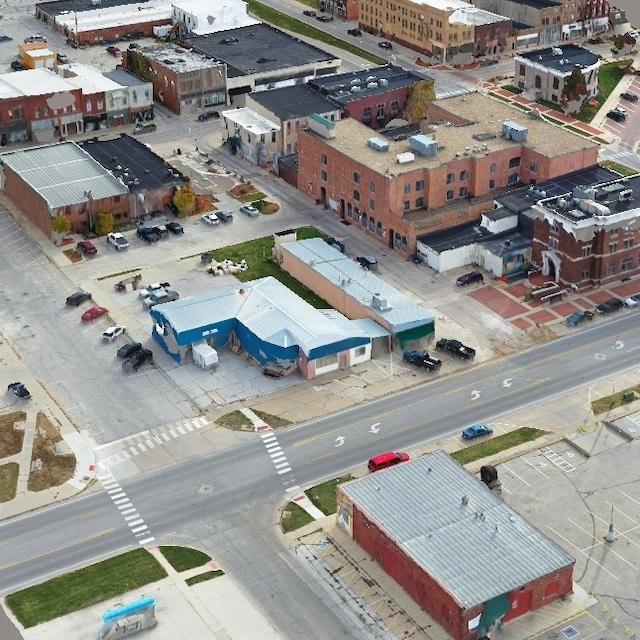
A city-scale digital twin of Perry, Iowa, created by the engineering firm Foth using Bentley Systems' software to process 375,788 images and 4.1 terabytes of information. (Image courtesy of Foth.)
Artificial intelligence (AI) could go a long way toward supporting trees and vegetation in cities. Trees have long been associated with sustainability and mitigating climate change. But as the climate has shifted into crisis mode, trees are integral to adaptation.
Their shade reduces ambient air and surface temperatures, diminishing the intensity of urban heat islands. Their leaves give off moisture that cools the air as it evaporates. And their canopies reduce the rate at which stormwater reaches the ground, while their roots encourage better absorption than soil alone, lessening the chance and intensity of floods. AI can strengthen trees’ ability to aid in climate adaptation and support sustainability in the process.
Companies are already using AI in natural spaces. The tech company IBM uses it to aid Kenya’s reforestation efforts, thanks to data from NASA satellites. Likewise, the infrastructure engineering software company Bentley Systems offers a program that creates AI-powered digital twins of cities for municipal planning and infrastructure management, including green infrastructure like trees.
Digital twins are accurate, virtual representations of real-world things that use real-time data to simulate the outcomes of potential scenarios. Pairing them with AI allows them to learn from the data they receive to offer better insights and predictions.
“We see more and more focus moving from a sustainability angle — or I would say, from a net zero angle — to a resilience angle,” Rodrigo Fernandes, the director of empowering sustainable development goals at Bentley Systems, told TriplePundit. “We see more customers and more users focused on ensuring that the infrastructure we have is ready … to adapt and to be resilient to the challenges that we will have in the future and the present because of climate change.”
Climate change puts more pressure on all types of infrastructure, from bridges to roads to greenery, he said. Digital twins aid in monitoring and inspecting each of these to support maintenance and planning. Municipalities can use them to create a digital map of the trees and vegetation in an area, a tech-enabled version of a process known as tree mapping.
The Singapore Land Authority uses the company’s digital twin software to do just that, mapping out its entire infrastructure, including the exact amount of trees and other greenery, Fernandes said. This can be done through satellite data or by putting sensors on cars, drones or, in Singapore’s case, aircraft.
“Our software [is used] to integrate, aggregate the data, and create the map,” he said. “They can easily quantify the amount of square meters or volume … [to] quantify their green infrastructure.”
These results are used to plan additional green infrastructure projects like increasing shade, improving air quality, mitigating flooding and more. Perry, Iowa also uses a digital twin to manage its man-made infrastructure and green spaces, including projects that restore natural spaces and reduce non-native species.
The software is also valuable for monitoring the health of existing trees. The AI can be trained to recognize tree health via the color of its leaves, Fernandes said. “In the case of Mendoza, Argentina, they had one million trees, so they applied it to the whole tree infrastructure,” he said. “Then they can use it to define actionable decisions like proactive maintenance.”
For tree mapping with digital twins to expand dramatically, a cultural shift is needed, Fernandes said. While city management might be aware of the need for a map in terms of sustainability and adaptation, they often have more pressing matters that need to be dealt with first. Nor is the availability of such technologies fully understood.
“They might think, ‘Okay we need to put more trees in a city eventually because we see the advantages of cooling, increasing quality of life, air pollution, and air quality improvement and all of that,” he said. But “they are simply not aware of digital technologies as an enabler.”
It remains to be seen whether municipalities will adopt such software as a part of sustainability and climate change mitigation on a large scale.
Clearloop Bases Renewable Energy Deployment on Environment and Health Impacts
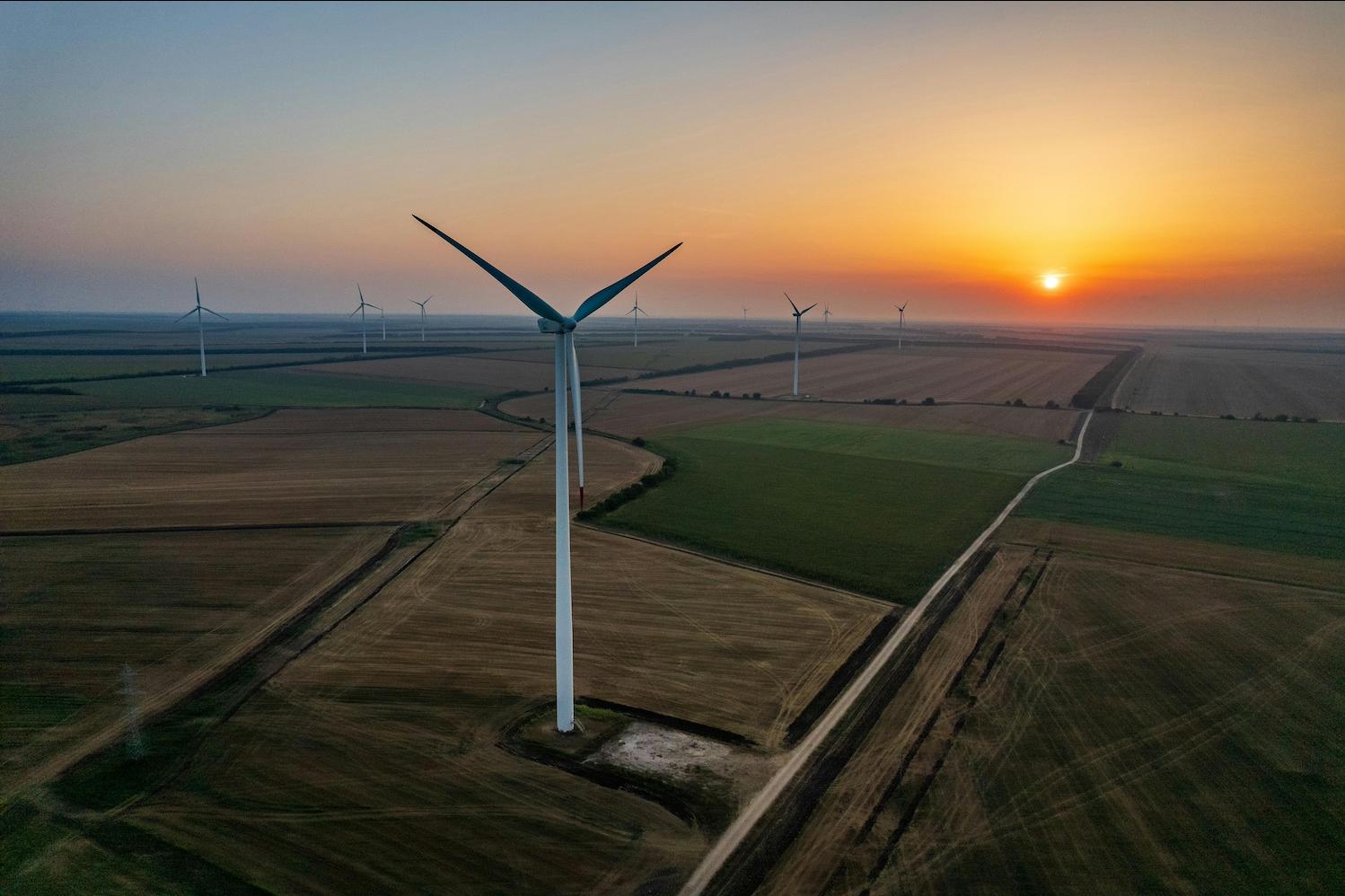
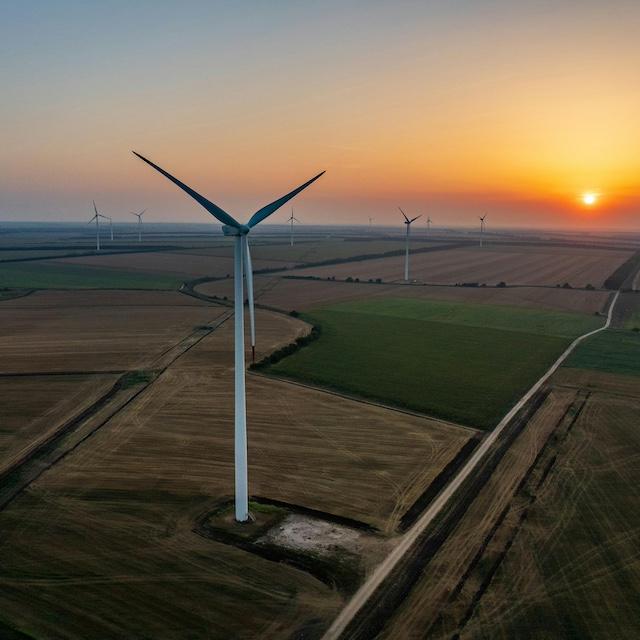
(Image: Stefan Mitev/Pexels)
In the United States, electric power is produced in a variety of ways, from coal to hydropower to wind and solar, with each type largely differentiated by region. Because of these significant variations, the effects new renewable energy projects can have on carbon emissions and air pollution vary greatly depending on the location.
In a recent paper, experts from the carbon solutions firm Clearloop and the climate data nonprofit WattTime examine the disparities in the U.S. electric grid and the implications for carbon accounting, decarbonization strategies and environmental justice.
“Everyone is familiar with the idea that renewables reduce emissions, but they need to understand how,” said Henry Richardson, senior analyst at WattTime. “To put it simply, when you build a solar plant, it replaces a fossil fuel plant on the grid. If you build a solar plant in California, it might be replacing other solar or natural gas. In the Midwest, a new solar plant would probably replace coal … Exactly what renewables displace is key, and it is not equal everywhere. The effect of those megawatt hours is different, and you can get two to three times the benefit depending on where you build. How do emissions change when you make a change in the electrical grid? That is what we measure.”
Energy accounting practices and rules are typically developed at an international level. While most countries use a national electric grid, the U.S. does not, meaning that a solar plant has a different impact depending on where it is placed.
“The way we count emissions doesn’t reflect this,” said Winston Vaughan, head of climate policy at Clearloop. “That is a missed opportunity in how we approach decarbonization and a huge opportunity for renewables to drive even more impact for climate and health.”
“Market-based carbon accounting treats all megawatt hours the same, but that is not actually true,” Richardson added.
Renewable energy’s human health impacts
Clearloop uses three criteria to determine where it will deploy a new renewable energy project: solar radiance, the social vulnerability of the region, and the emissions impact a project could have in any area. The company measures social vulnerability by evaluating income levels, community investments over time, job creation rates and other factors.
“We take a different angle on renewable energy procurement by looking for places where it can drive the most good from both the climate and community impact perspectives,” Vaughan said.
Carbon emissions are often a reliable indicator for other types of pollution that occur when burning fossil fuels, such as mercury and particulate matter, Vaughan said. Those emissions have a significant impact on human health in the communities that host fossil fuel-based power plants.
“We already see huge health disparities from unequal exposure rates, but unless we are conscious in the way we deploy clean energy resources, there is a real risk of widening human health inequities,” he said.
How carbon markets can reduce barriers to renewable energy deployment
One of the barriers to deploying more renewable energy projects in underserved communities is a lack of financing. That is where the voluntary carbon market (VCM) can come into play.
“There is a reason why carbon financing dollars are flowing to certain places,” Vaughan said. “It is cheaper and easier to build renewable energy projects in some places than others, because of market obstacles.”
A fossil fuel plant requires continuous purchase of coal or natural gas. While a solar plant might be capital-intensive to build, the cost of generating electricity is almost zero because it comes from the sun.
“It’s difficult for solar plants to be profitable in places where it isn’t clear how much money they can make from selling electricity to the grid, like in Louisiana, Mississippi and Tennessee, where there is a monopoly on utilities,” Vaughan said. “Monopoly markets make it much more difficult to make up for the investments in a solar plant, but that’s where the VCM can come in. We have buyers who are paying upfront for building a new solar project on the grid, and they can get the full lifetime of environmental attributes, whether they’re renewable energy certificates or carbon credits.”
Carbon financing allows project developers to take a bet on riskier markets where there is more uncertainty about selling the electricity over a long period of time.
“There has been a lot of controversy about the role of the VCM, benefits, costs on local communities and Indigenous rights," Vaughan said But he believes there is a role for the VCM to play to help bring down market barriers that prevent the development of renewable energy in a more equitable way. “There is a failure to recognize inequities in the U.S. carbon market, and because we don't recognize those disparities, we haven't deployed resources in the VCM to address that. VCM is a powerful tool to overcome these market obstacles and drive investment where it can have the biggest impact.”
The path forward
Targeted deployment of renewable energy projects is key to smart, effective decarbonization.
“Building more solar in California is not as beneficial as it could be elsewhere,” Richardson said. “Same with wind energy in the Great Plains. Before we start a new project, we need to ask if we are displacing fossil fuels or if we are displacing other renewables.”
“We have to address climate change, and it is also an opportunity to not just reduce carbon emissions but build a more equitable world for the people who live here,” Vaughan added.
Vaughan also acknowledged that the projects are in the early stages, so the data about the economic development of targeted renewable energy deployment is not fully materialized.
“However, on a tangible basis, we can measure the tax dollars we are paying,” Vaughan said. “We buy the land we build on instead of leasing, we are there for the long haul and we have a stake in the community. That manifests in how we take care of the land, from planting native grasses to mowing with sheep flocks to partnering with local farmers. It really matters to local economic development offices and local communities.”
The Paris Olympics Prove Reusable Packaging Is Possible On a Massive Scale


Fans gather behind the Eiffel Tower for a women's beach volleyball match between Germany and France at Champ de Mars Arena in Paris on July 28. (Image: Alain Grosclaude via France Olympique/Flickr)
It seems the whole world is talking about the Paris 2024 Olympic and Paralympic Games, from athletes performing superhuman feats to Snoop Dogg's wealth of comic relief on the sidelines. More than 15 million people flocked to France's capital to feel part of the action, with over 3 million holding tickets for the games. Many of those spectators noticed something new when they stopped by a snack stand for their favorite beverage, as the Paris Olympics are the first to serve drinks in reusable packaging, in partnership with the France-based company Re-uz.
The Paris Olympics are the largest sports event ever to replace single-use beverage cups with refillable alternatives, and advocates hope it will send a clear message to event organizers and beverage brands that reuse is possible on a large scale.
"The objective of doing the Olympics was to show the world and to show everyone that it's doable — if there is a will, if you plan and if it's organized," said Octave Pirmez, sales director for Re-uz, which provides reuse and refill services across six European countries and parts of Canada.
That's good news for the planet, considering the equivalent of more than 280 billion beverage bottles are washed into the world's oceans every year. If nothing changes, the production of plastic — much of it single-use — will account for an estimated 20 percent of the world's oil consumption and up to 15 percent of the global carbon emissions that drive climate change by 2050. The dangers climate change pose to our way of life — and the sports we love — were on full display in Paris as temperatures soared above 95 degrees Fahrenheit in a national weather emergency that scientists say would have been “virtually impossible” if not for rising emissions.

Reuse at the Paris Olympics raises awareness of the possibilities beyond disposable
Founded in 2006, Re-uz powers reuse setups at major events like the Wimbledon tennis championships and music festivals across Europe, along with a Starbucks reusable cup pilot in France and the Billie Cup returnable cup program at more than 200 eateries across Belgium, among other efforts.
The company's system is fairly simple: It offers a selection of reusable cups and food-ware to customers, and it provides services to pick up, wash and return the packaging for reuse. All of the company’s reusable packaging is designed to maximize recyclability at end of life and is made in France to reduce environmental impact, according to Re-uz. A network of washing centers across Europe minimizes excessive shipping, with Re-uz teams operating at more than 32 sites within France alone for distribution, logistics, washing and delivery of reusable packaging.
Re-uz will utilize this existing infrastructure to support reuse at the Olympics. Cups from the Paris games will be sent to the company's Paris washing center staffed entirely by people with disabilities, while empties from football and sailing events in southern France will head to another washing center in Marseille, Pirmez said.
Even before partnering with the Paris Olympics, the company washed more than 80 million cups over the past five years, helping to avoid an estimated 129 tons of single-use plastic, according to its parent company Impact Group.
With millions of drinks set to be poured at the Paris Olympics, the potential for avoiding waste — and raising awareness among spectators — is huge. "Most people, especially at the Olympics, have never experienced reusables, so it's a first time for them," Pirmez said.
Re-uz has already received inquiries from global attendees looking to set up similar wash and refill systems at events and venues in their home countries. "We had a lot of requests from South America, and we had some requests from the Middle East," Pirmez said. "Definitely it helps to sensitize people to reuse and that there is another solution — there is an alternative to single-use."
Still, the first reuse system at the Olympics didn't always meet gold-medal standards, with advocates including the ocean conservation nonprofit Oceana calling out examples like vendors pouring beverages from single-use plastic bottles into reusable cups. But Re-uz and other reuse advocates hope the effort will send ripple effects that go far beyond Paris, particularly when it comes to convincing major event organizers and beverage companies that reuse is viable at scale.
"Obviously it's not perfect, but it's also to show Coke and all the big beverage companies that it can be done — and that's a major positive step for reusables," Pirmez said.
Athletes and advocates push beverage giants to go further
The Olympic Games count some of the world's largest companies as longstanding partners, including the beverage giants Coca-Cola and PepsiCo. Though the beverage majors sell some drinks in refillable packaging, primarily in Europe and Latin America, reusables still make up less than 15 percent of their global drink sales.
Athletes and advocates are looking to speed the transition further. In an open letter penned last month, more than 100 sports organizations and athletes — including Olympians competing in Paris — called on Coca-Cola, PepsiCo and bottler Coca-Cola Europacific Partners to make reusable an option for all of their customers globally by 2030.
"In July, Oceana supported the action of over 100 sports organizations and elite athletes who sent a letter to leading event sponsors Coca-Cola and Pepsi, calling on them to make future sporting events run on reuse rather than single-use — they didn’t ask for both," Dana Miller, Oceana’s director of strategic initiatives, told TriplePundit in an email. "We want to see more reusable packaging at events in the future, and we want to see it done right.”
The athletes who signed say the move toward reuse is imperative to preserve the sports they love and ensure a cleaner environment for future generations. “I’ve competed in events around the world — and everywhere I sail, I find single-use plastics polluting our waters and shorelines,” Lara Dallman-Weiss, an Olympic sailor for Team USA and a signatory to the open letter, said in a statement. “One thing is clear, more needs to be done to stop the plastics crisis.”
Re-uz has already inked an contract with Coca-Cola to deploy reusables at more of their events in Europe, and it aims to leverage its presence at the Olympics to bring reusables to more major venues worldwide, Pirmez said.
"Our objective is to keep pushing for event organizers to switch from disposable to reusable, and I think the Olympics will show everyone that it's doable because if we did it with the Olympics, we can do it for smaller events," he said. "There are still a lot of possibilities, basically everywhere where there is a disposable, and when it makes sense, the objective for us is to keep pushing to convince them to switch."
Homepage image: nicolas michaud/Flickr
Carbon Capture Can Compliment the Circular Economy with E-fuels
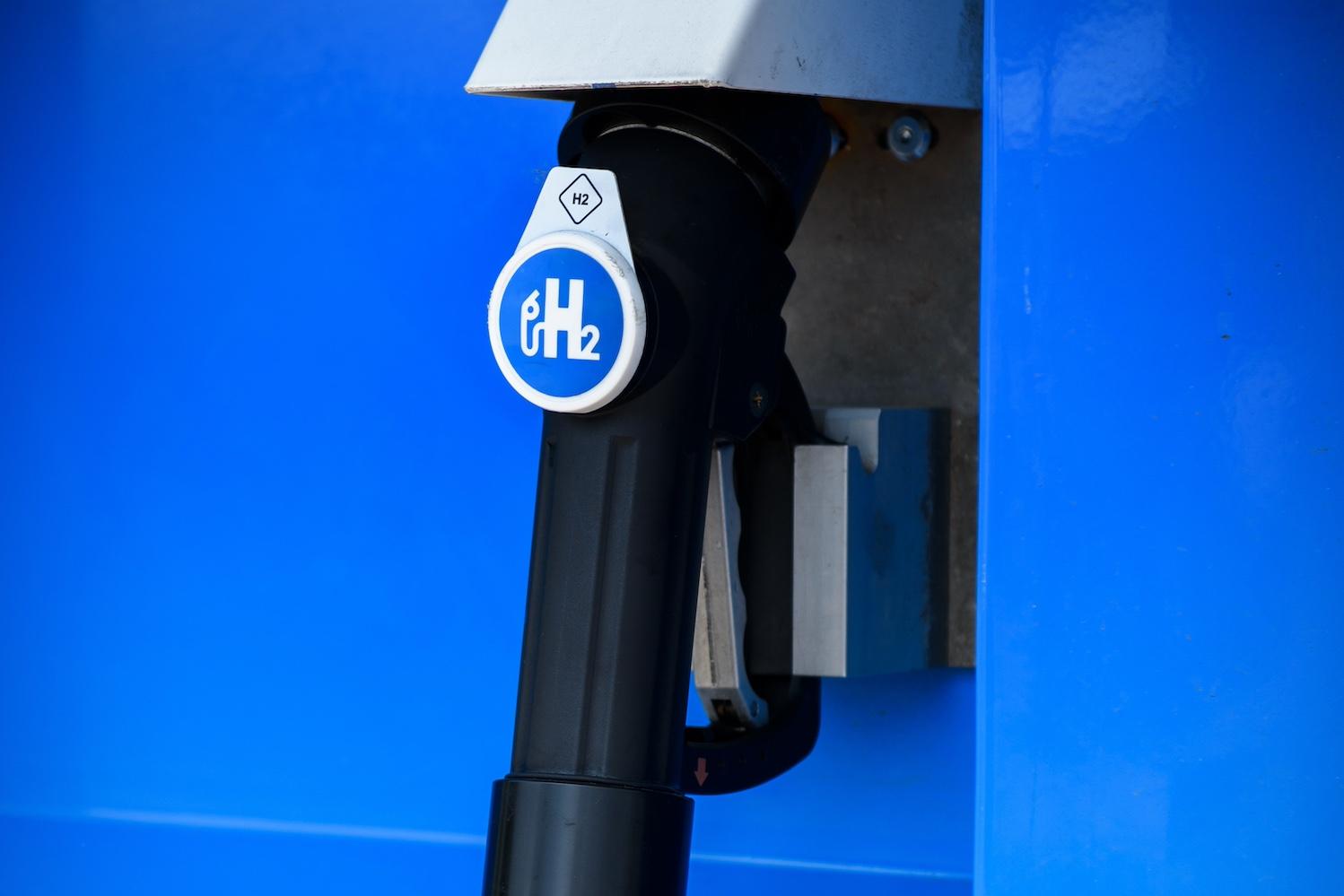
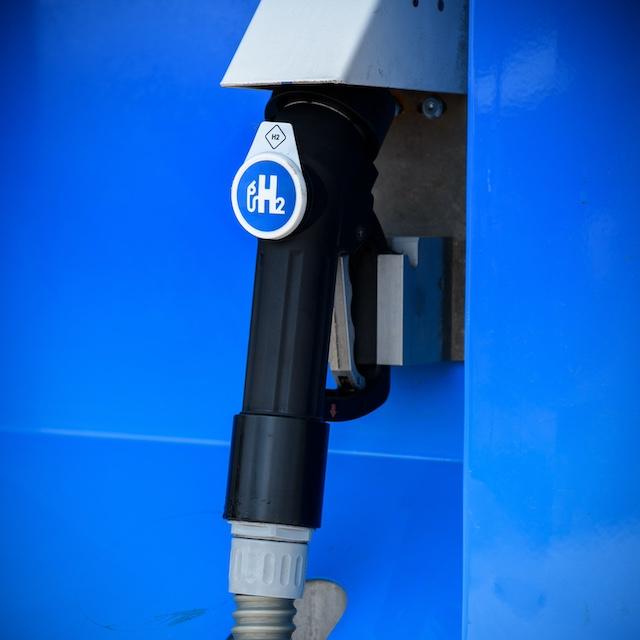
Captured carbon can be used to create synthetic e-fuels that replace fossil-fuels. (Image: Dirk Vorderstraße/Wikimedia Commons)
The carbon capture field has come under fire, with critics charging that it simply enables fossil energy stakeholders to continue extracting coal, oil and natural gas from underground. But not all carbon capture systems are alike. When airborne carbon dioxide is used to replace fossil-sourced fuels or chemicals with synthetic ones, carbon capture systems can contribute to the circular economy and help stimulate more renewable energy development, too.
Wind, solar and the renewables-to-liquids movement
The connection between renewable energy and synthetic fuels is already emerging in the field of e-fuels. Also called solar fuels or electrofuels, these new synthetic liquid fuels use electricity to run electrolysis systems, which separate water into hydrogen and oxygen. That is a significant sustainability improvement over the conventional hydrogen supply chain, which depends on extracting hydrogen from natural gas, or coal to a lesser extent.
With this green hydrogen in hand, carbon is another ingredient needed to make new liquid fuels and chemicals, and that can come from carbon capture systems.
Still, e-fuels do not fit the circular economy model if the electrolysis equipment runs on electricity from a coal or gas power plant. Low-cost wind or solar power makes all the difference.
Solving the renewables-to-grid puzzle
One of the key obstacles faced by wind and solar developers is a simple matter of transmission availability. Optimal locations for renewable energy development are abound in the U.S., but many are in remote locations. Building new transmission lines and connecting them to the nation’s grid can be a difficult, if not impossible, endeavor.
The e-fuels field can provide a solution by converting and transporting renewable energy in liquid form, rather than depending on a grid connection. Liquids, e-fuels and chemicals can be transported using existing infrastructure, including pipelines, roads, railways and shipping ports. E-fuels can also leverage existing tank farms and other facilities for storage. In contrast, storing electricity from wind or solar farms involves building new battery arrays and other energy storage systems.
To be clear, risks and hazards are always present when transporting or storing fuels and chemicals, sustainably sourced or not. But with the risks and hazards of climate change in full view, e-fuels present an opportunity to address a broader crisis from two sides: replacing extractive resources with more sustainable ones and capturing airborne carbon.
Who’s going to pay for all this?
Another key obstacle is cost. Though the cost of green hydrogen is dropping, the United States Department of Energy calculates that low-carbon fuels cost about $10.00 per gallon, far above the typical cost of fossil-sourced gasoline and other fuels.
To push costs down and help accelerate the renewables-to-fuels movement, the Department of Energy launched $41 million in funding for new reactor-based systems that process renewable energy, water and captured carbon into new fuels and chemicals.
“Renewable energy resources are often not co-located with the current U.S. power grid, and by enabling the transportation of sustainable fuels the selected projects can reduce interconnection barriers while helping cut emissions from hard to decarbonize industrial sectors,” according to the department’s Advanced Research Projects Agency-Energy office (ARPA-E), which is charged with administering the fund.
ARPA-E’s mission is to fund new, transformative energy systems that have not attracted sufficient support from private investors. This funding marks the first time it is supporting efforts to make liquid fuels.
A new decarbonization pathway
ARPA-E makes it clear that the new funding program is aiming for synthetic fuels that can be used as a drop-in replacement for conventional fuels. That will make a significant contribution to decarbonization over the coming years. Though electric vehicle sales are picking up, millions of gas- and diesel-fueled vehicles will remain road-worthy long into the future, and they will continue to use liquid fuels of one kind or another.
Sustainable aviation fuels are also a target of the program. The North Carolina startup Susteon previously received awards from the Department of Energy and the North Carolina Department of Commerce. Now, its receiving an additional almost $5 million from ARPA-E for five innovations in the production of sustainable aviation fuels, including an energy management system that optimizes the availability of wind or solar energy.
The new program is yet another indication that simply capturing airborne carbon and injecting it underground is an outdated approach that fails to proactively replace fossil energy with renewable resources. New systems and technologies are presenting a more sustainable, alternative pathway.